This document contains a summary of an introductory chapter from the Handbook of Applied Cryptography. It provides an overview of cryptography and discusses its purpose in ensuring information security. The key goals of cryptography are described as confidentiality, data integrity, authentication, and non-repudiation. Various cryptographic primitives and techniques are introduced that can provide these security properties, such as encryption schemes, hash functions, and digital signatures. The chapter also discusses criteria for evaluating cryptographic primitives like security level, functionality, performance, and ease of implementation.

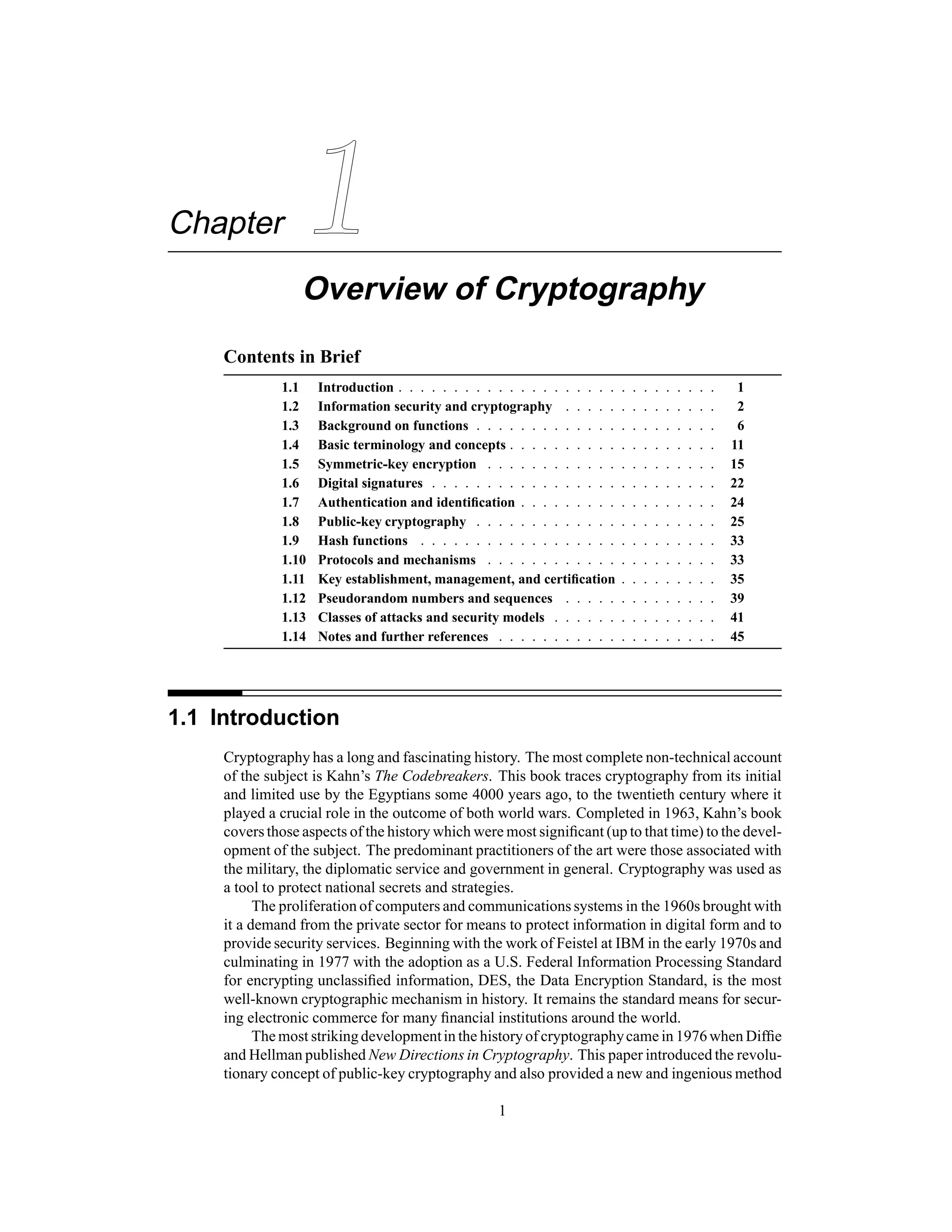
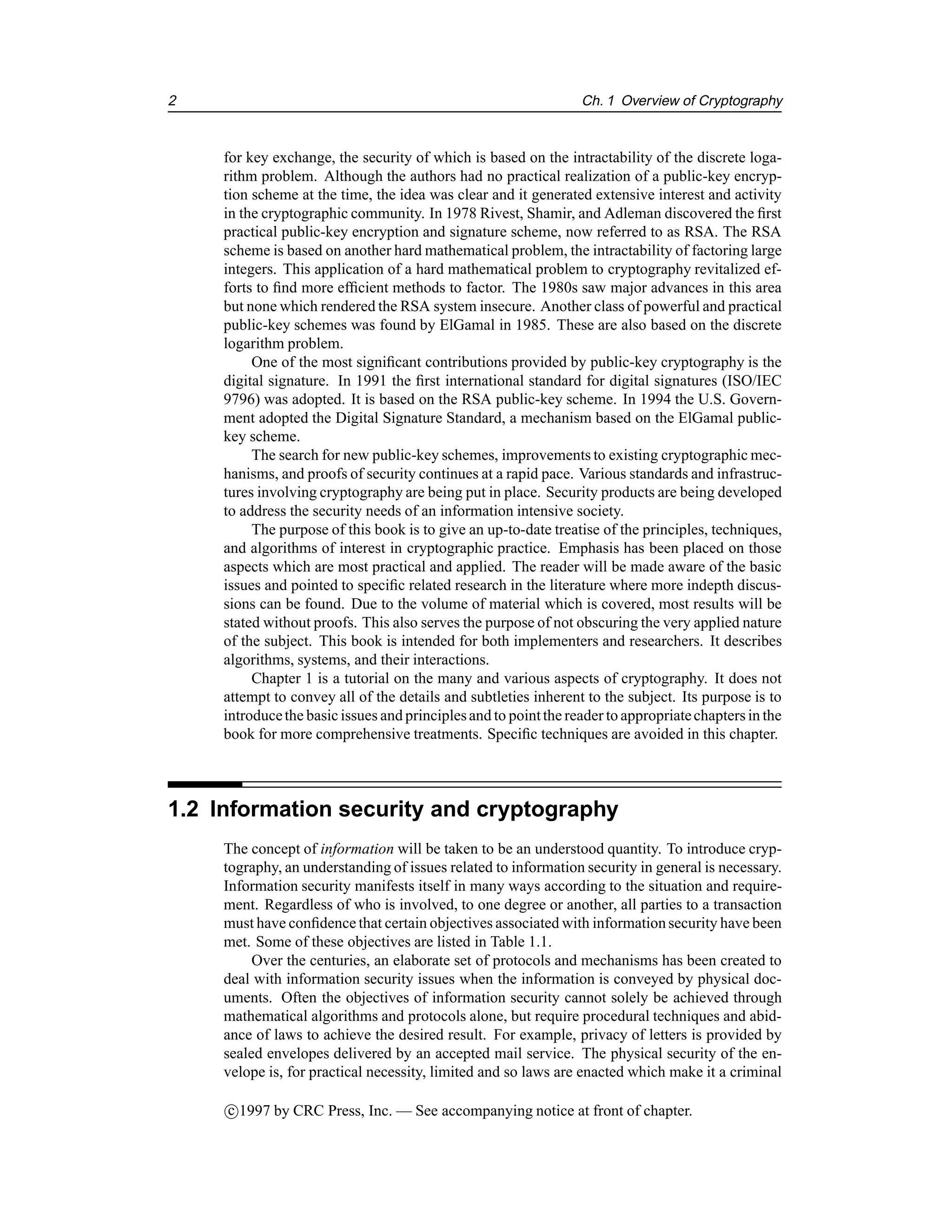
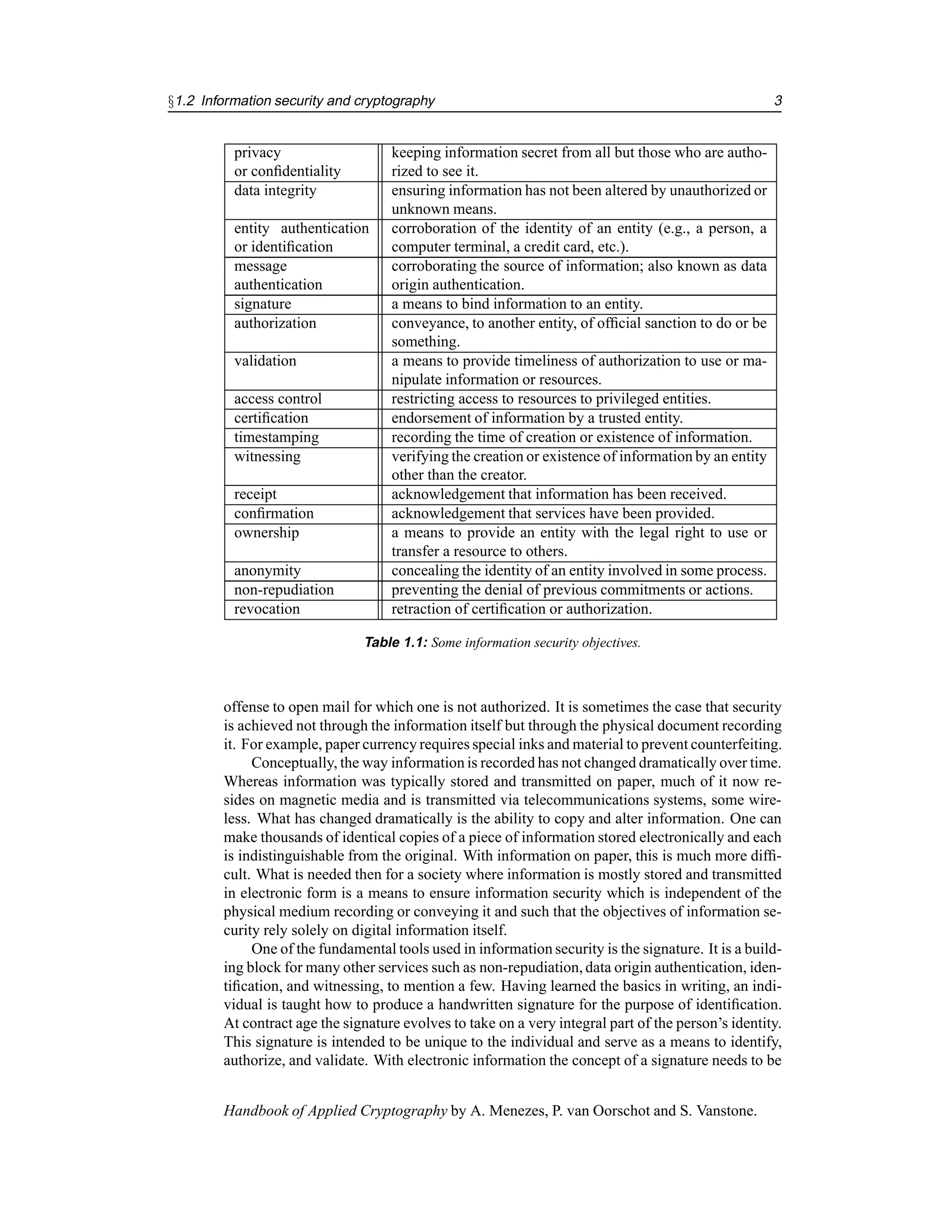
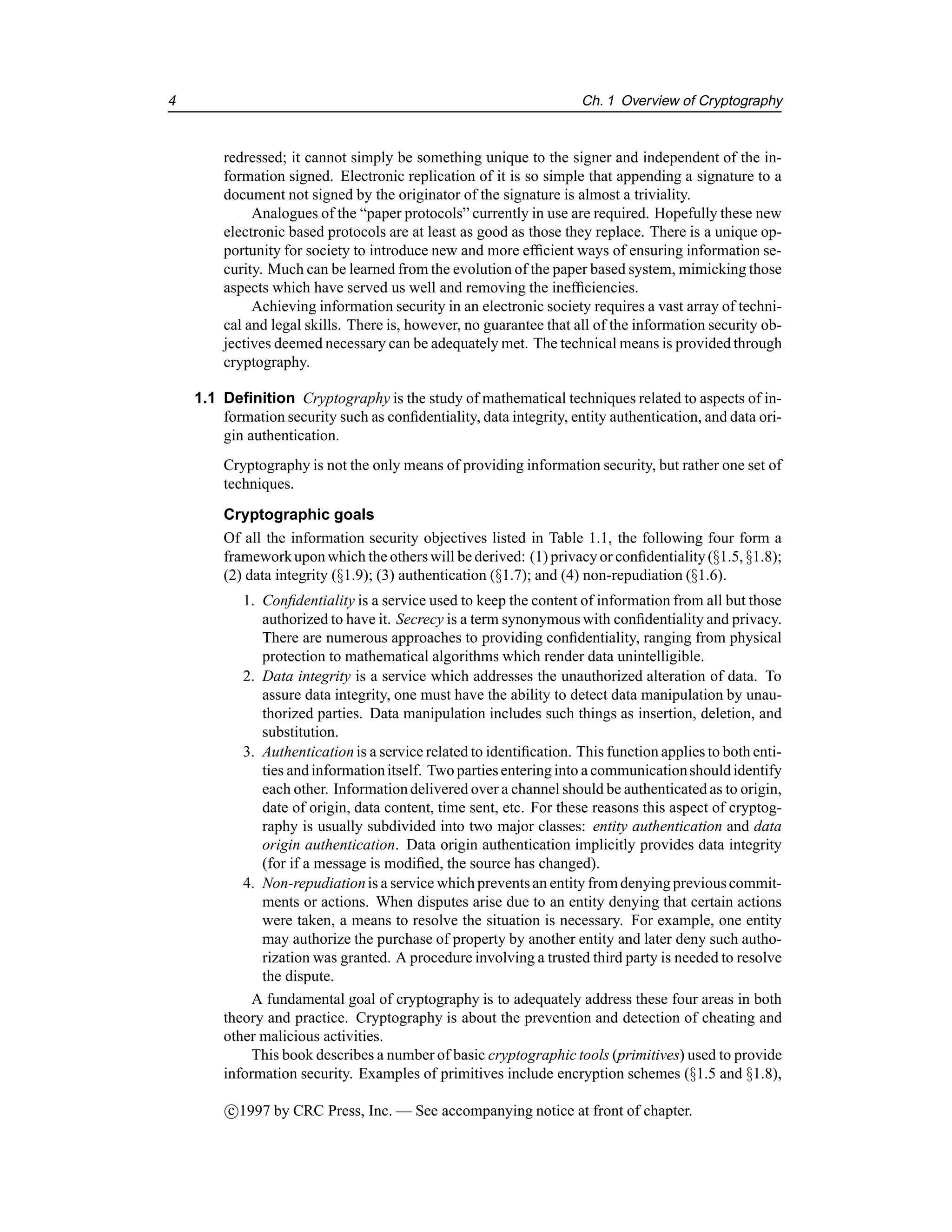
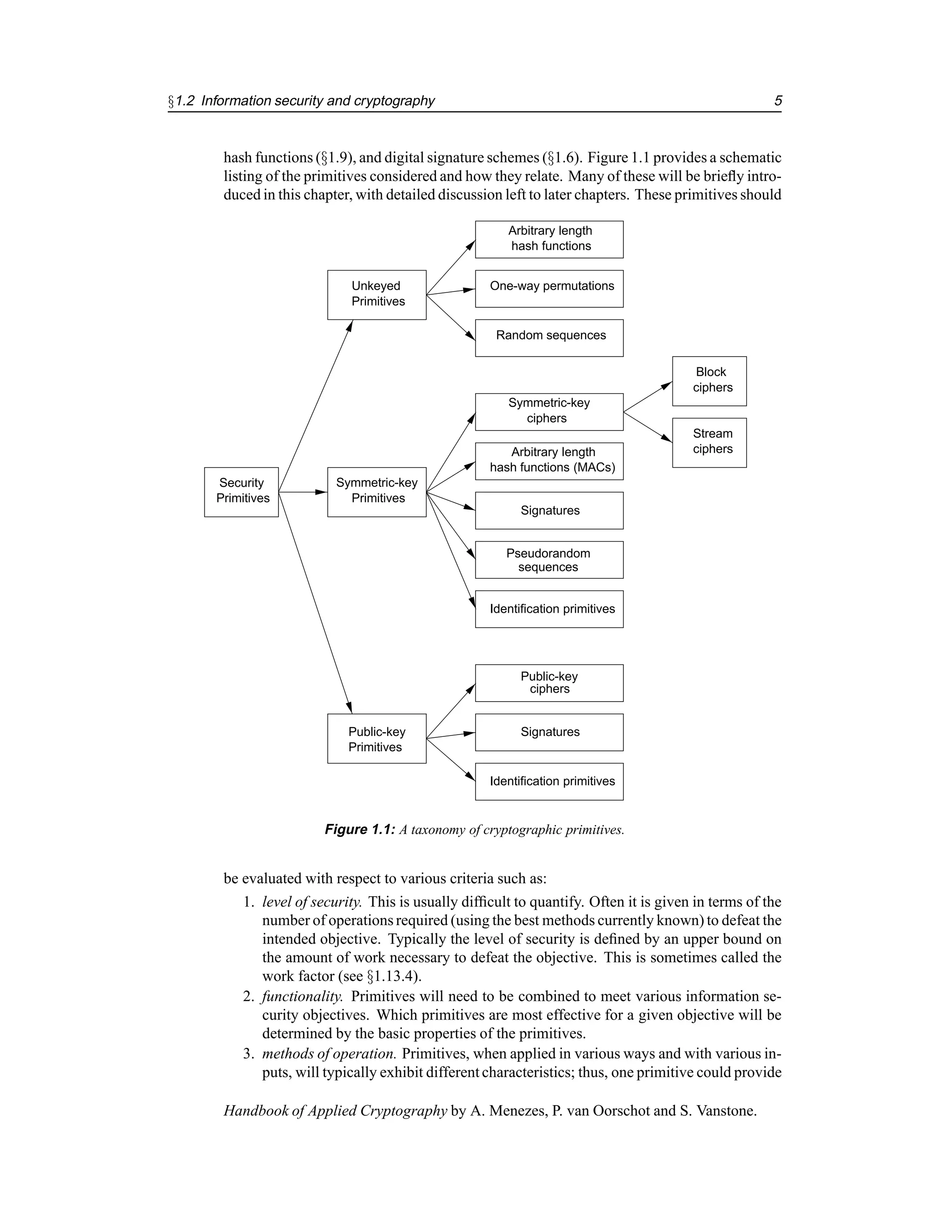

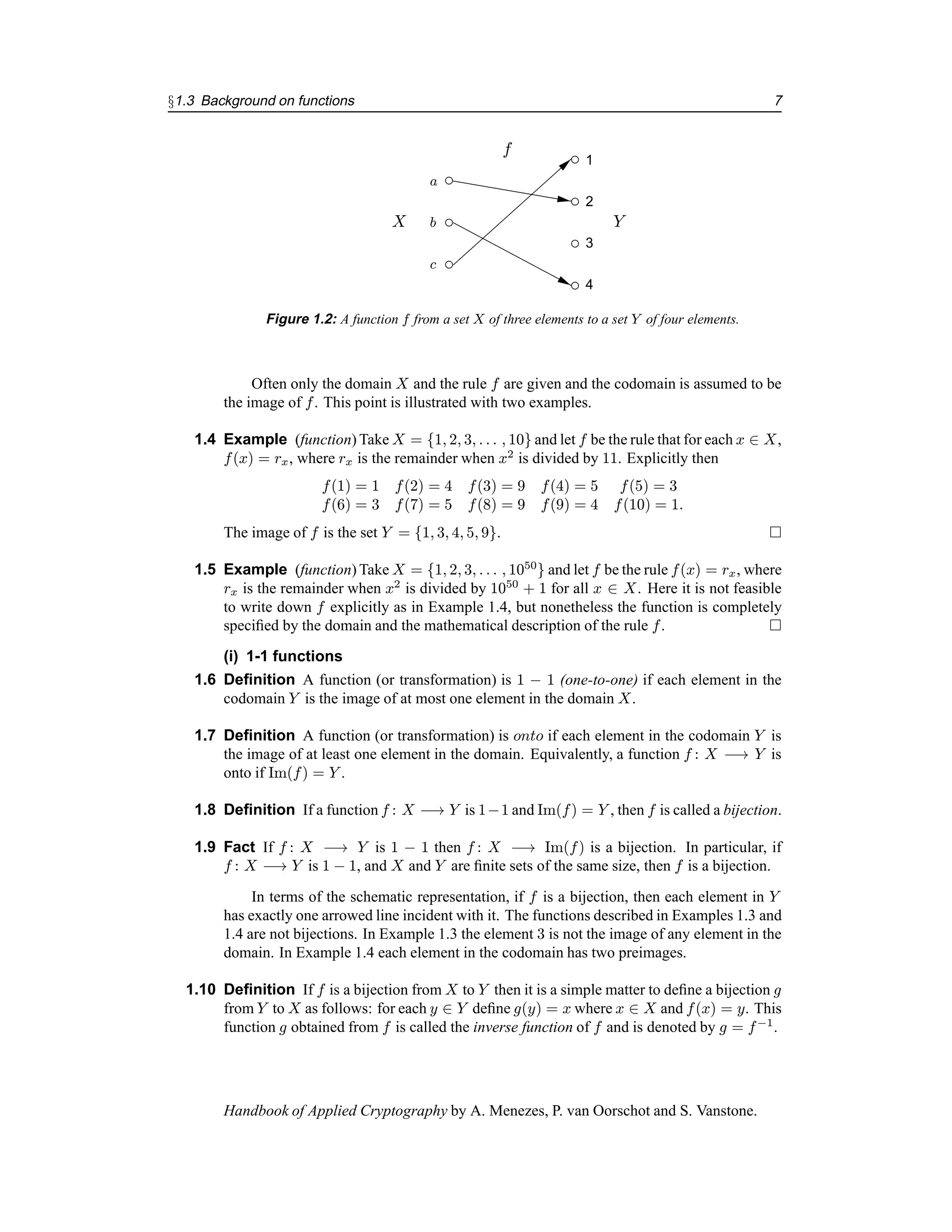
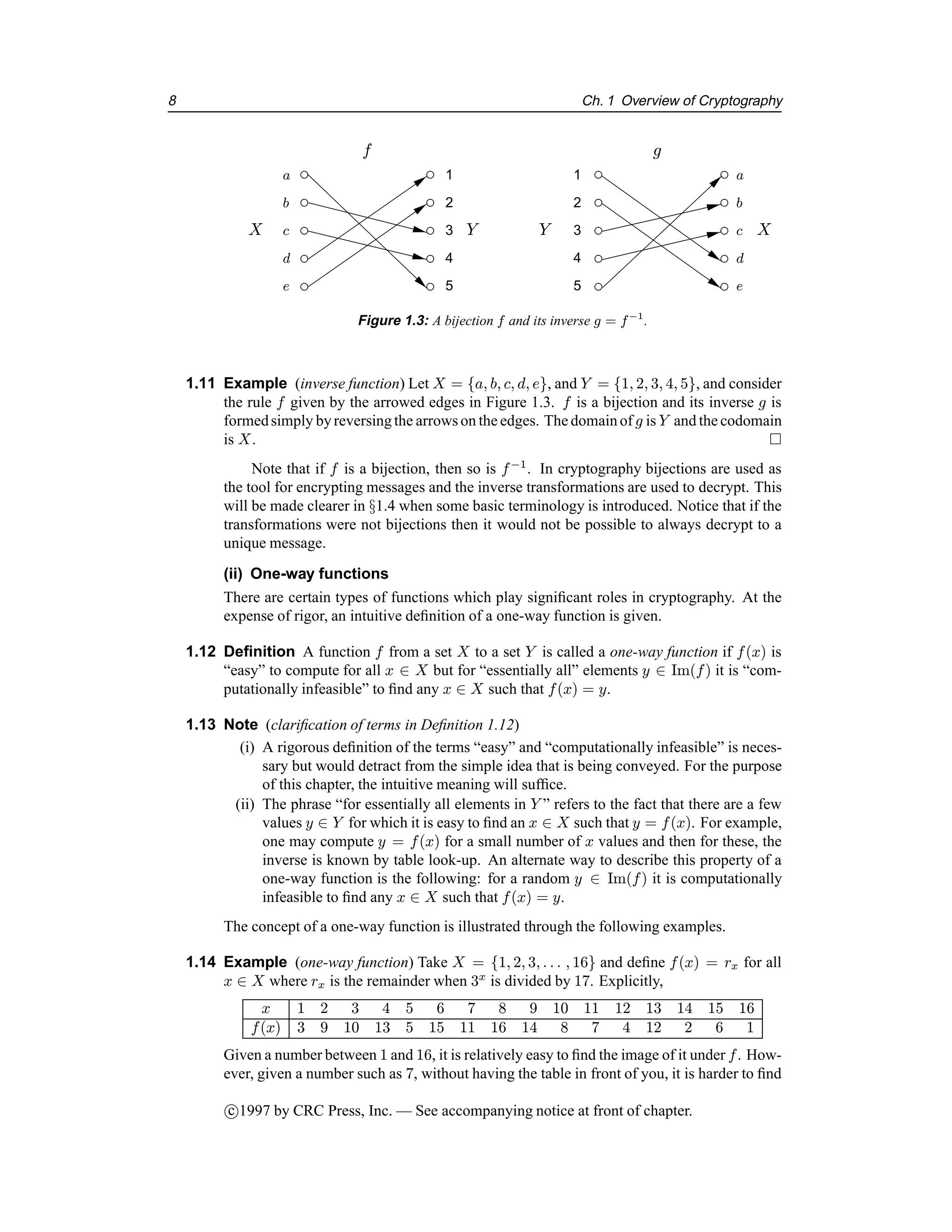
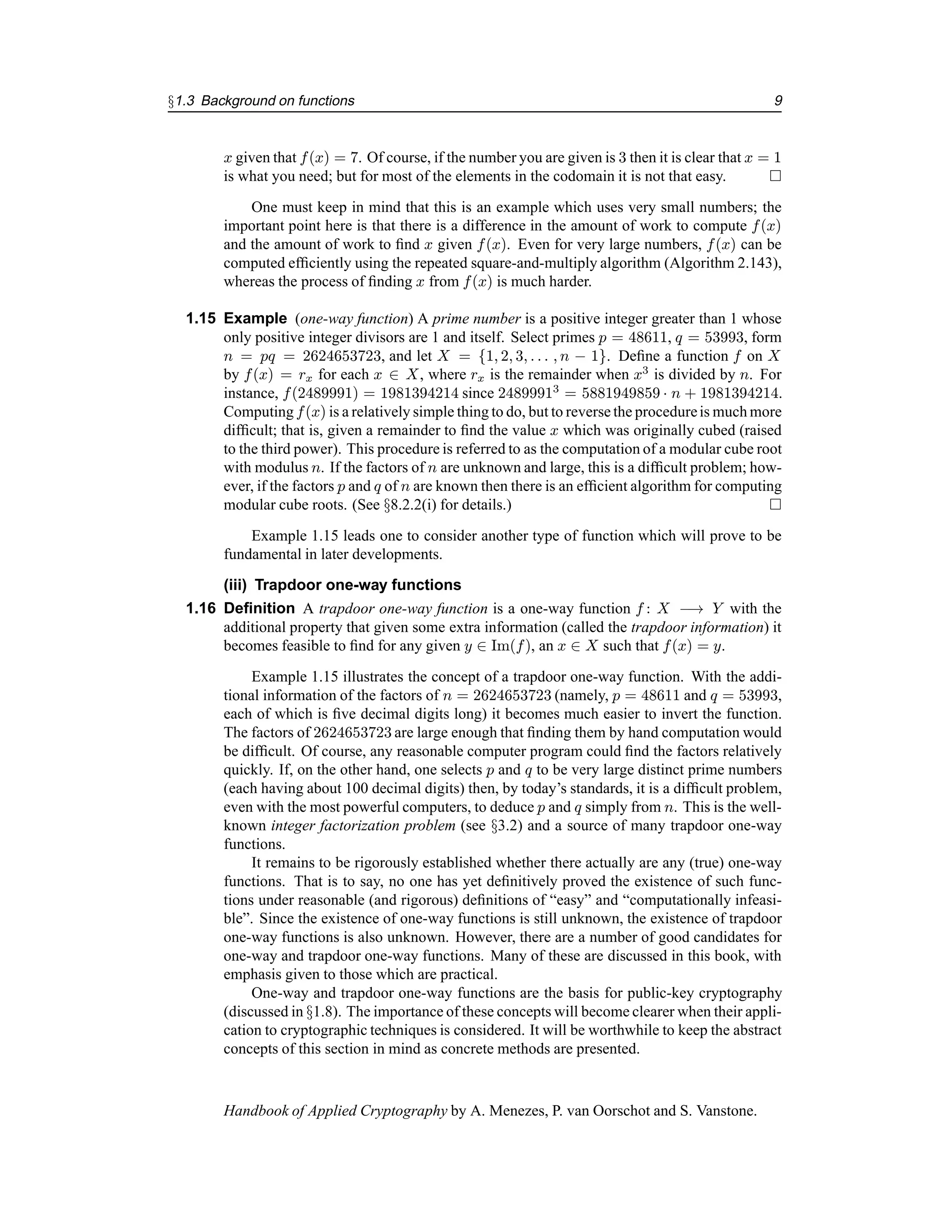
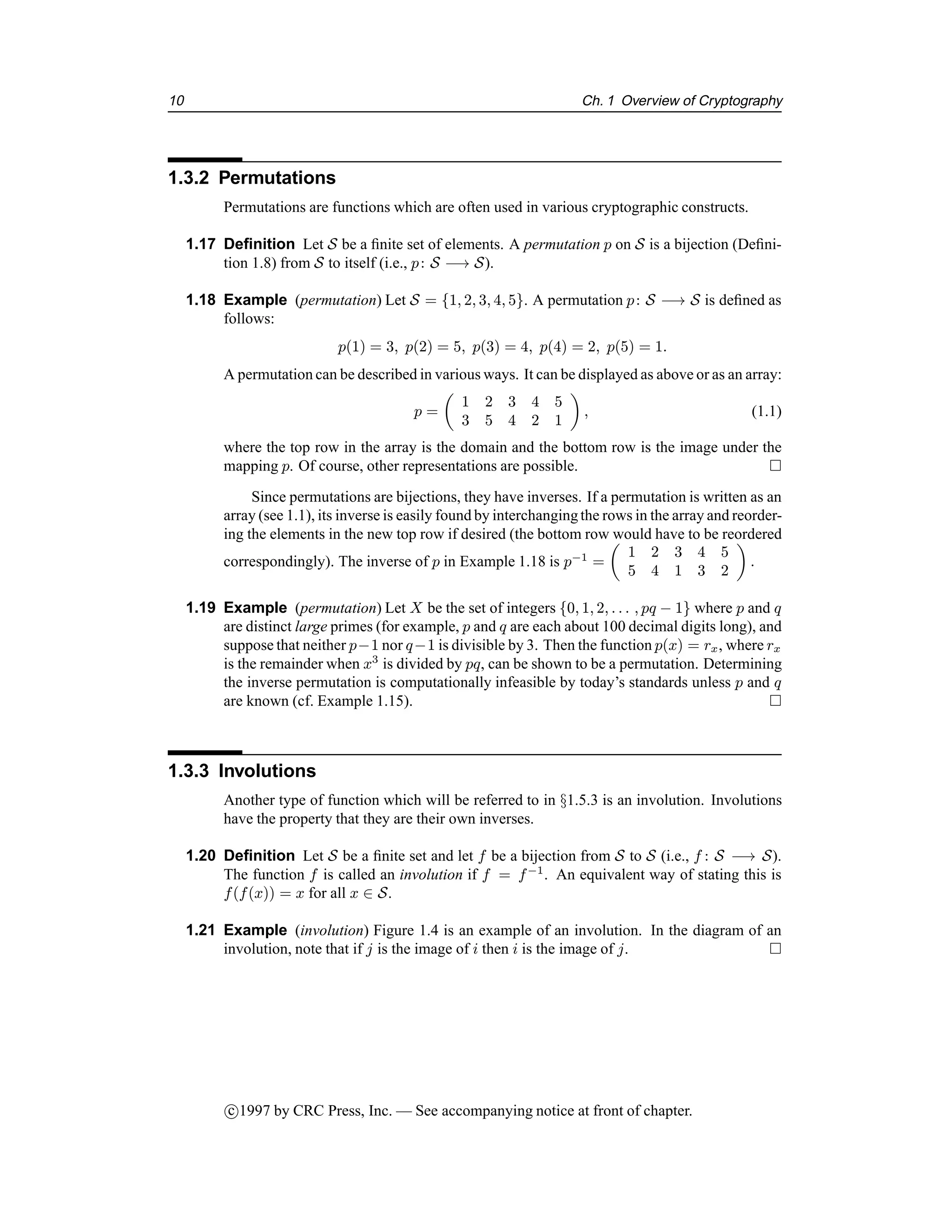
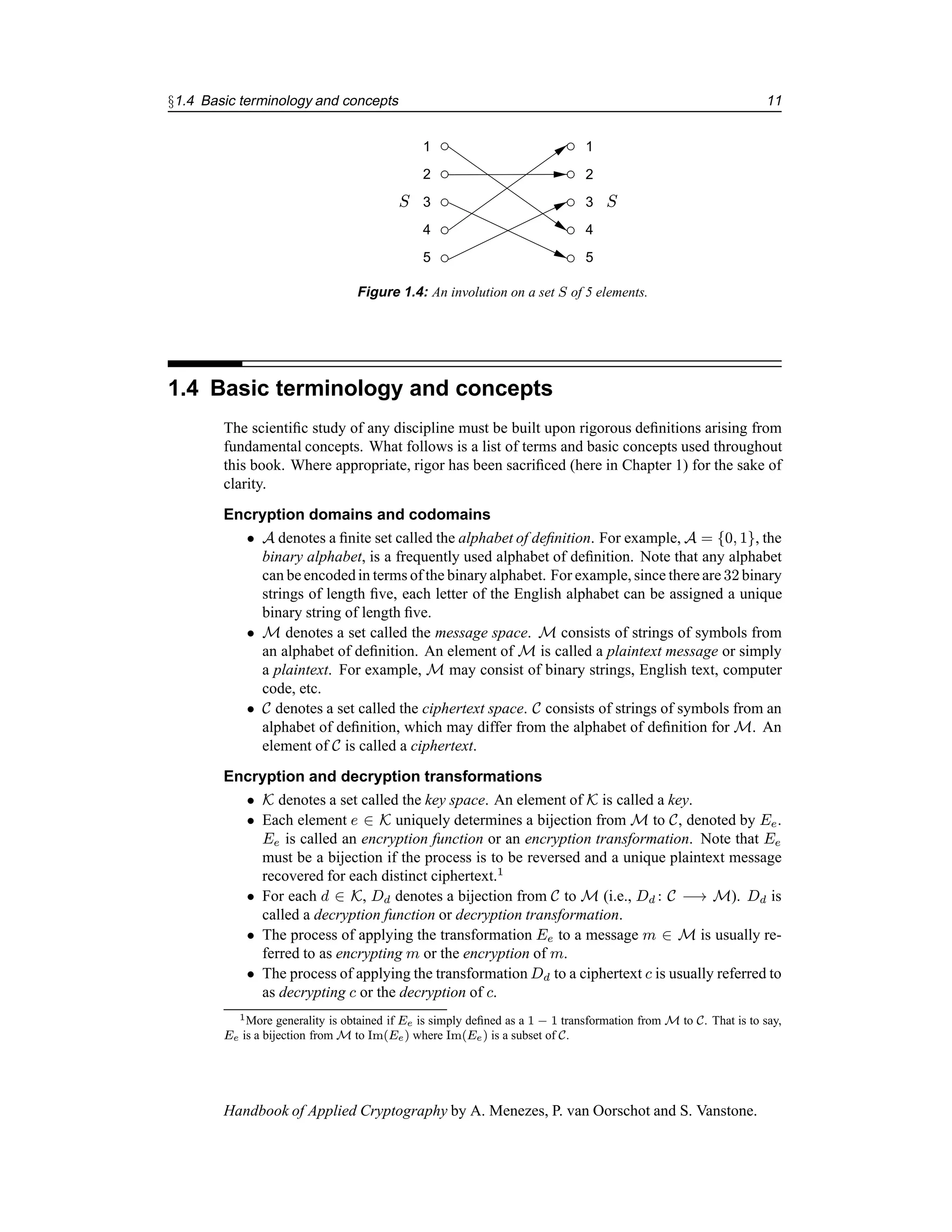
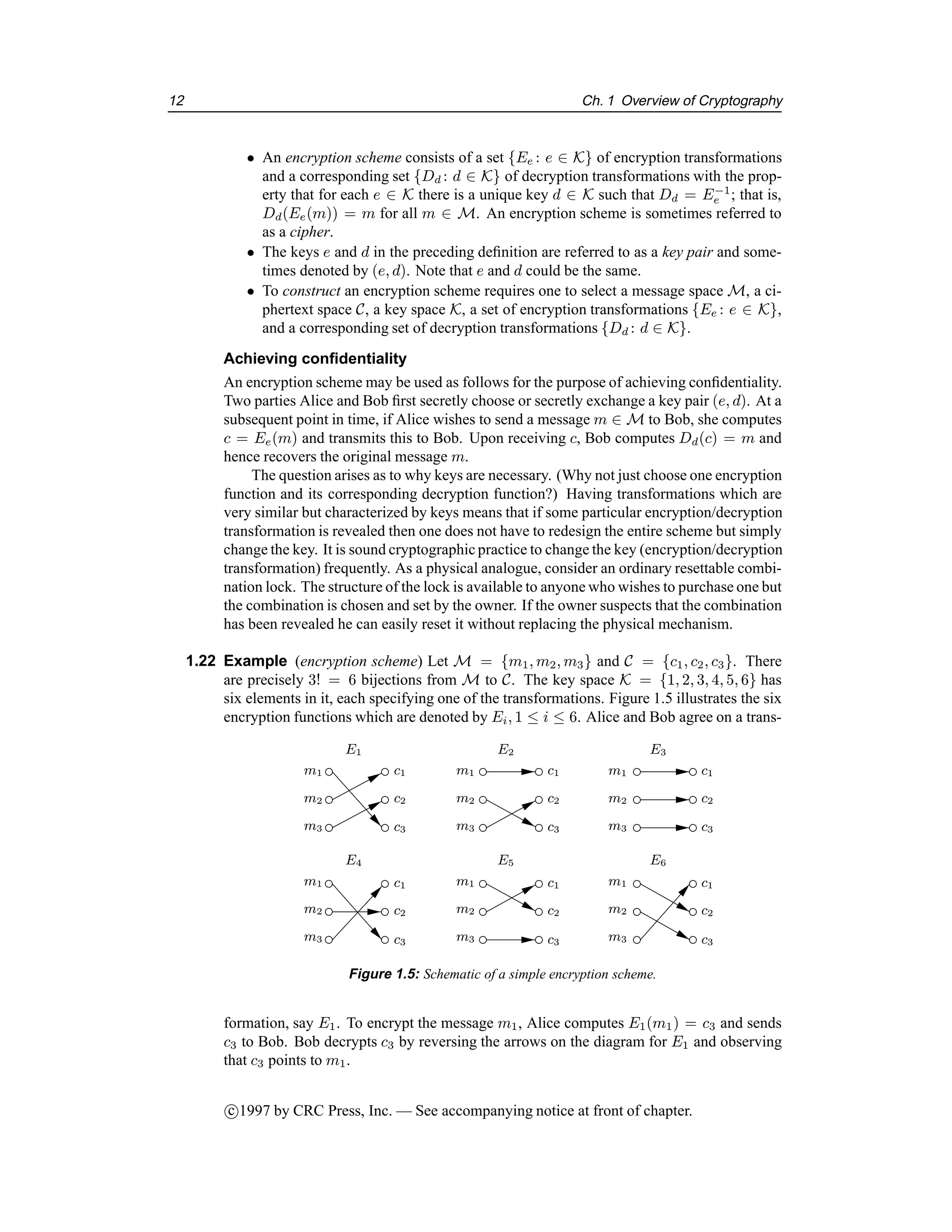
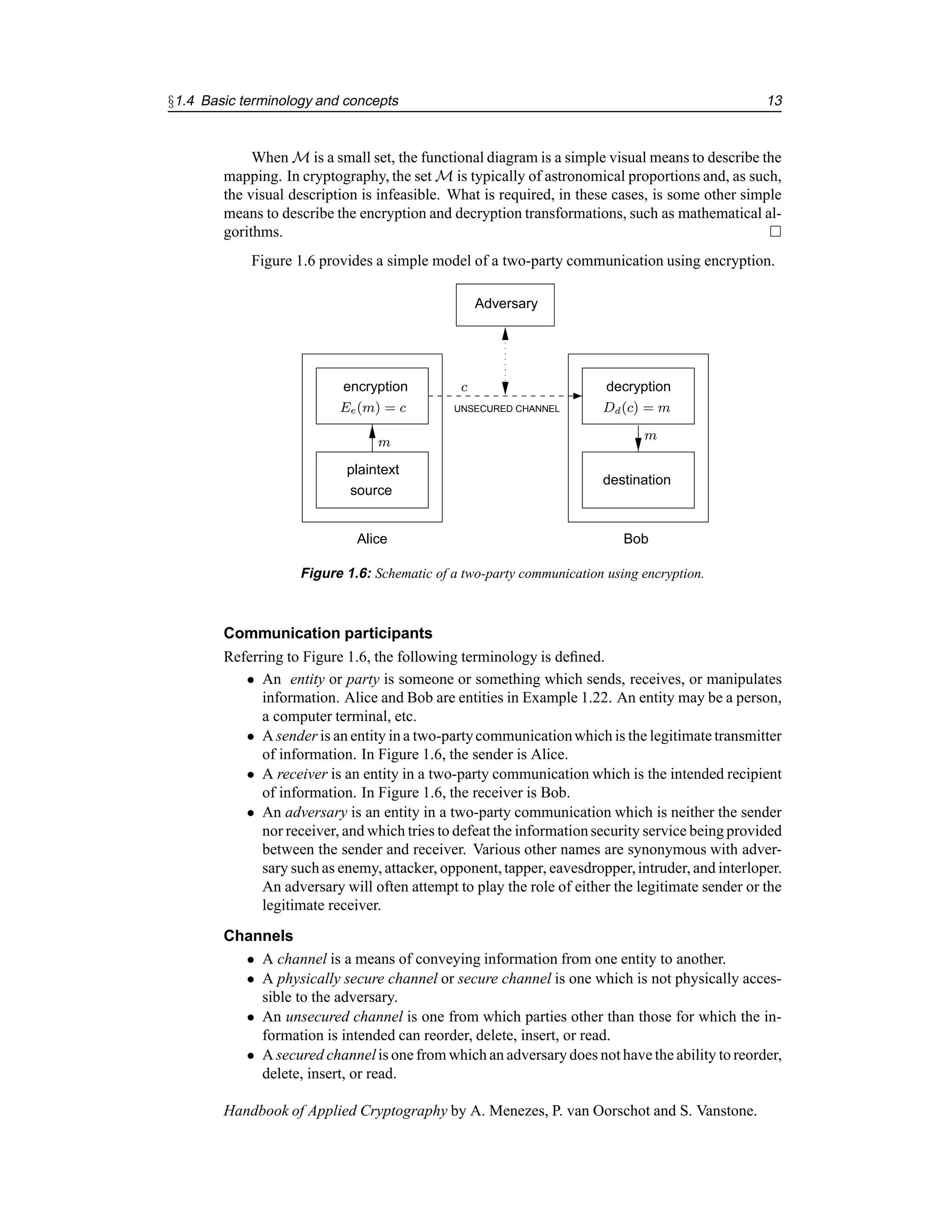
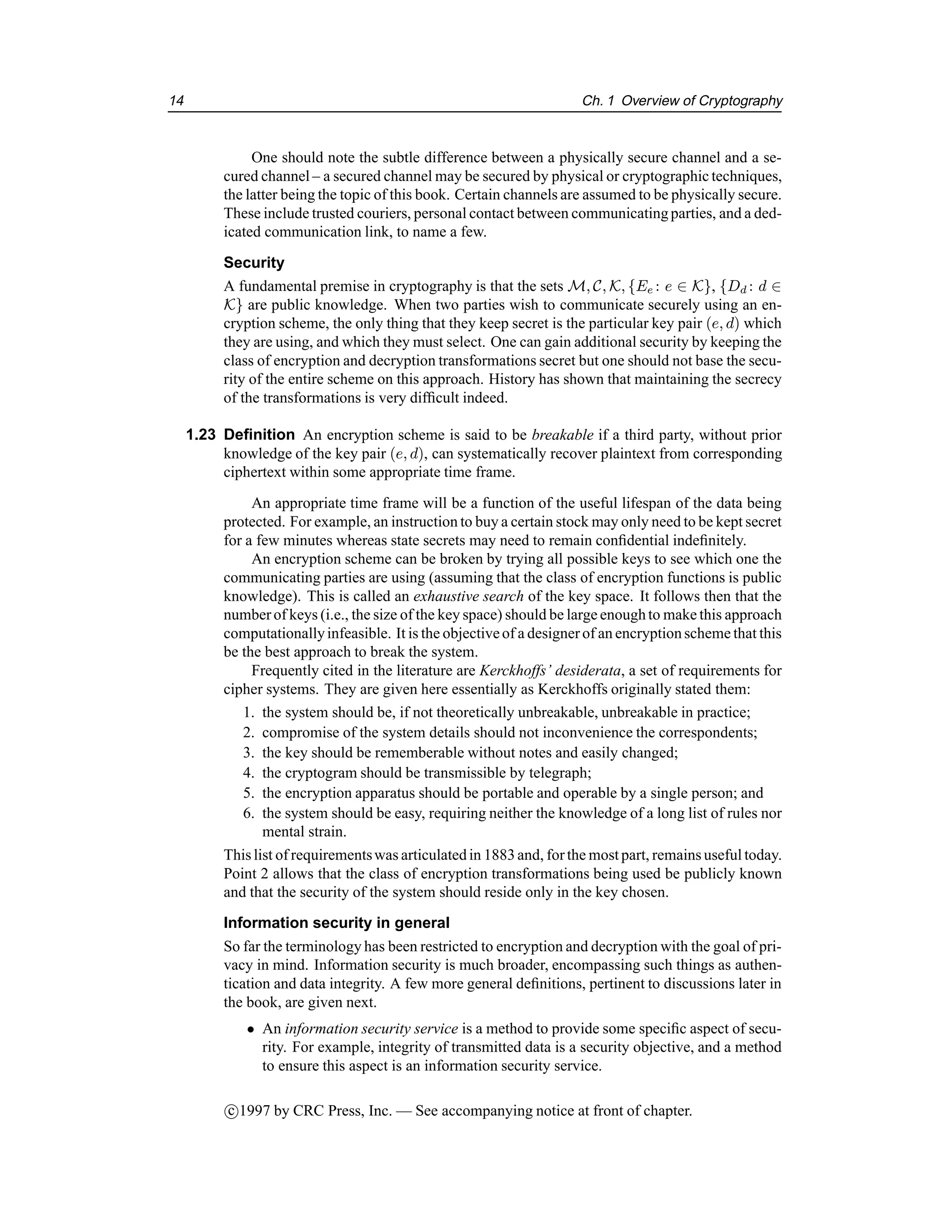
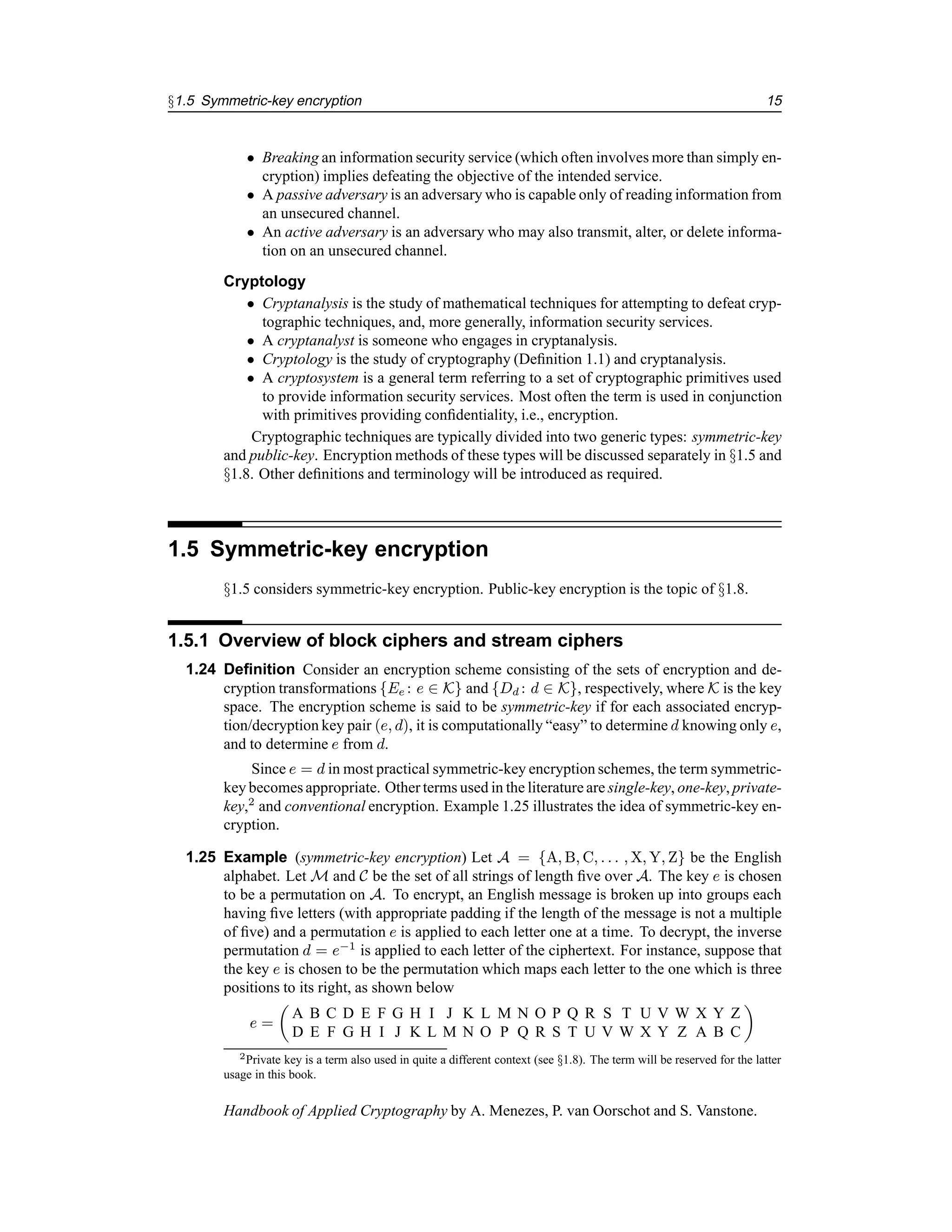
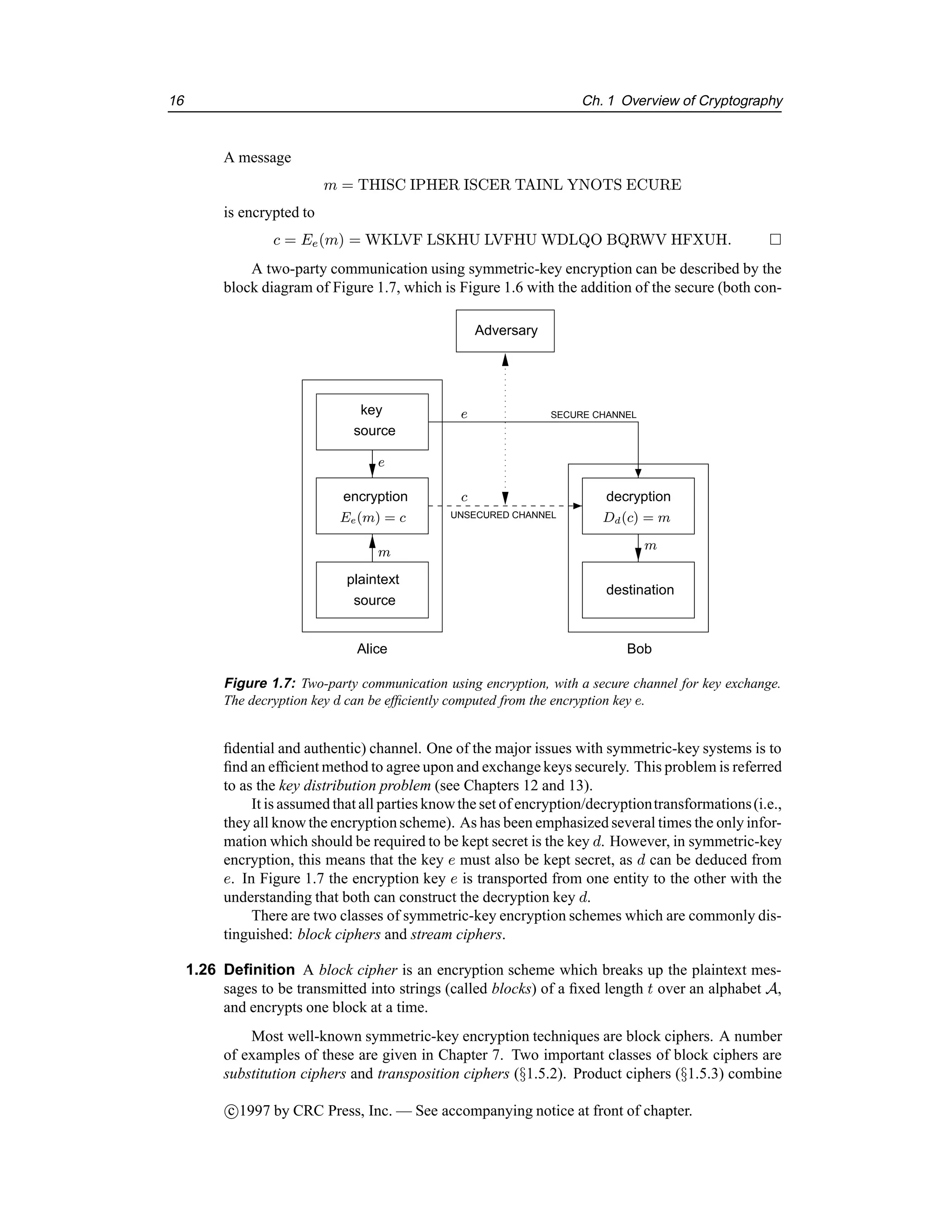
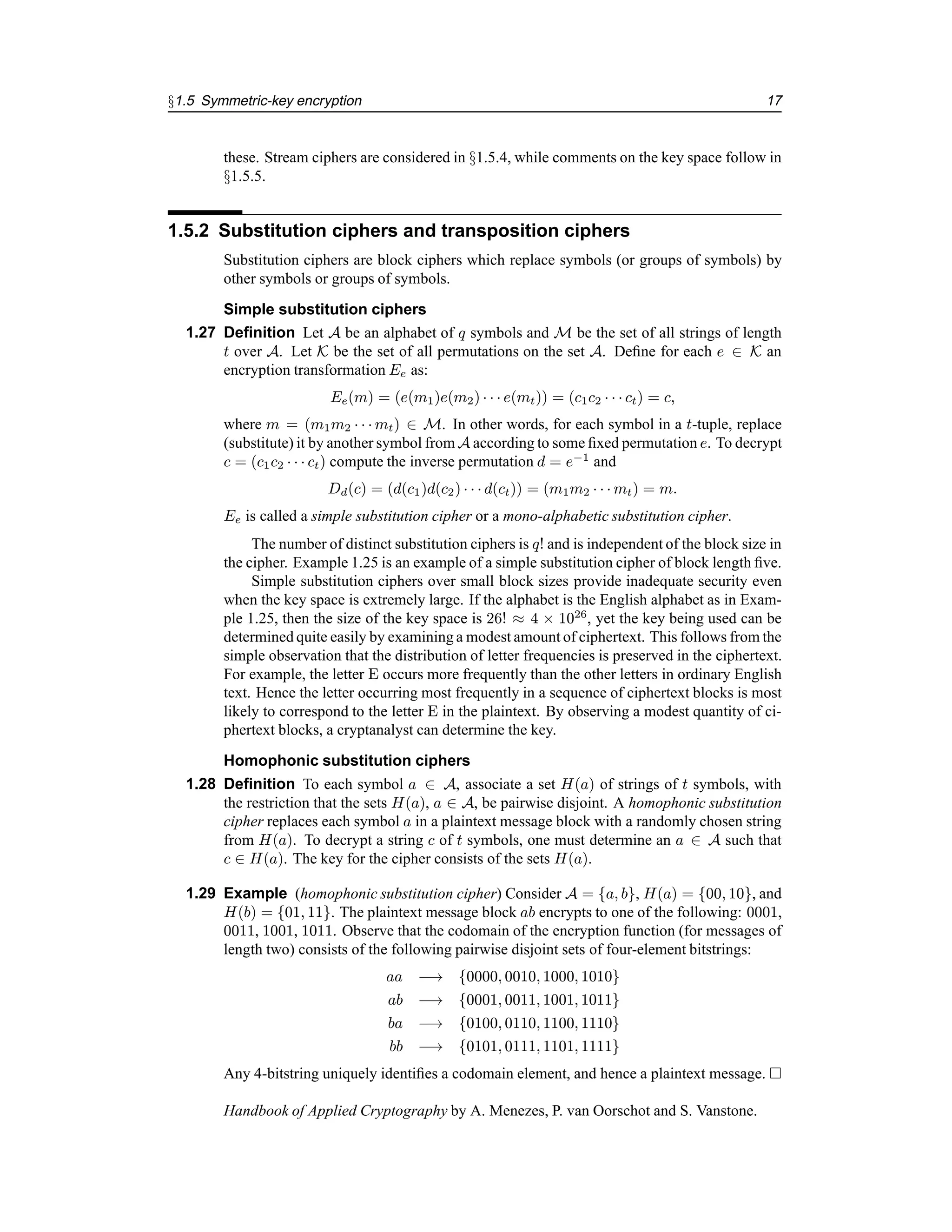

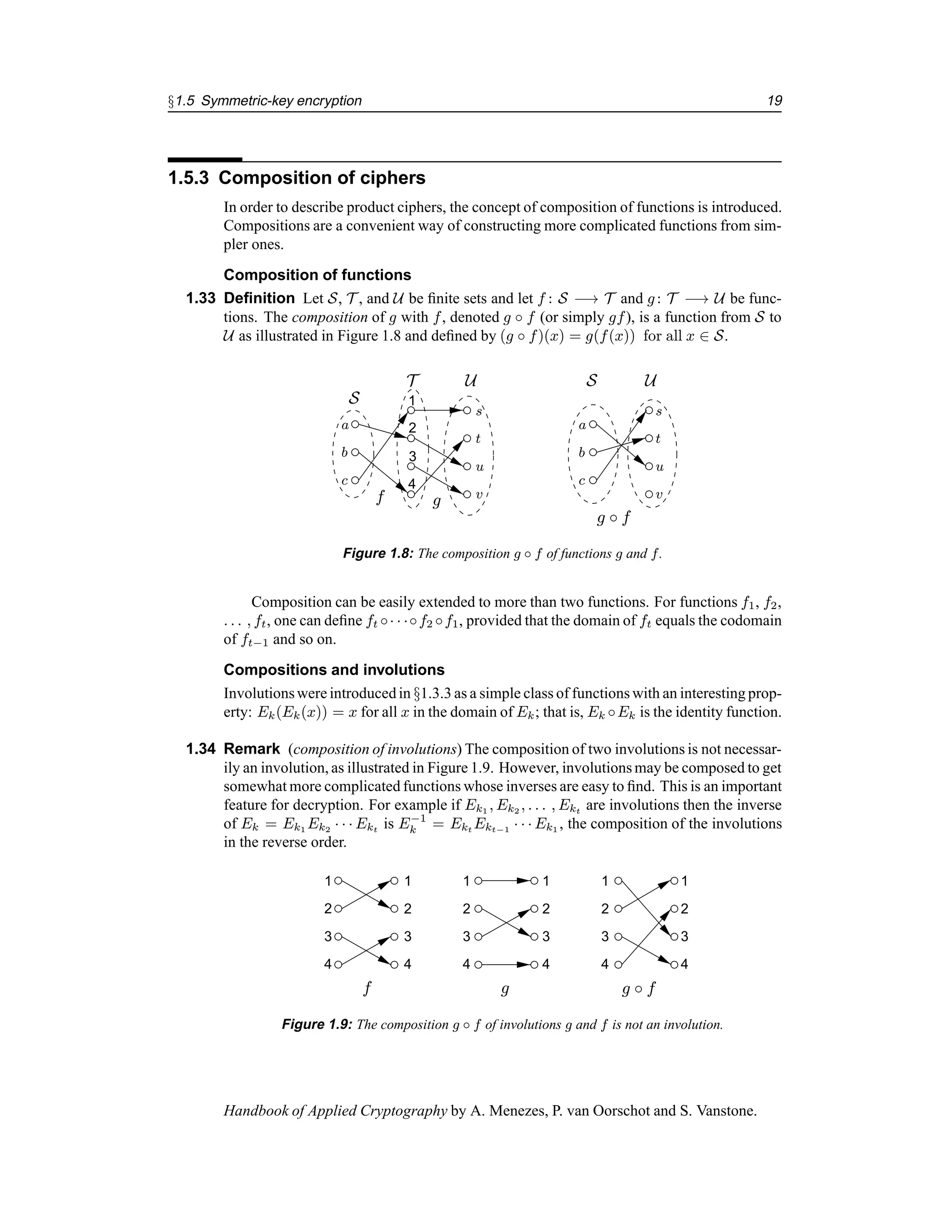
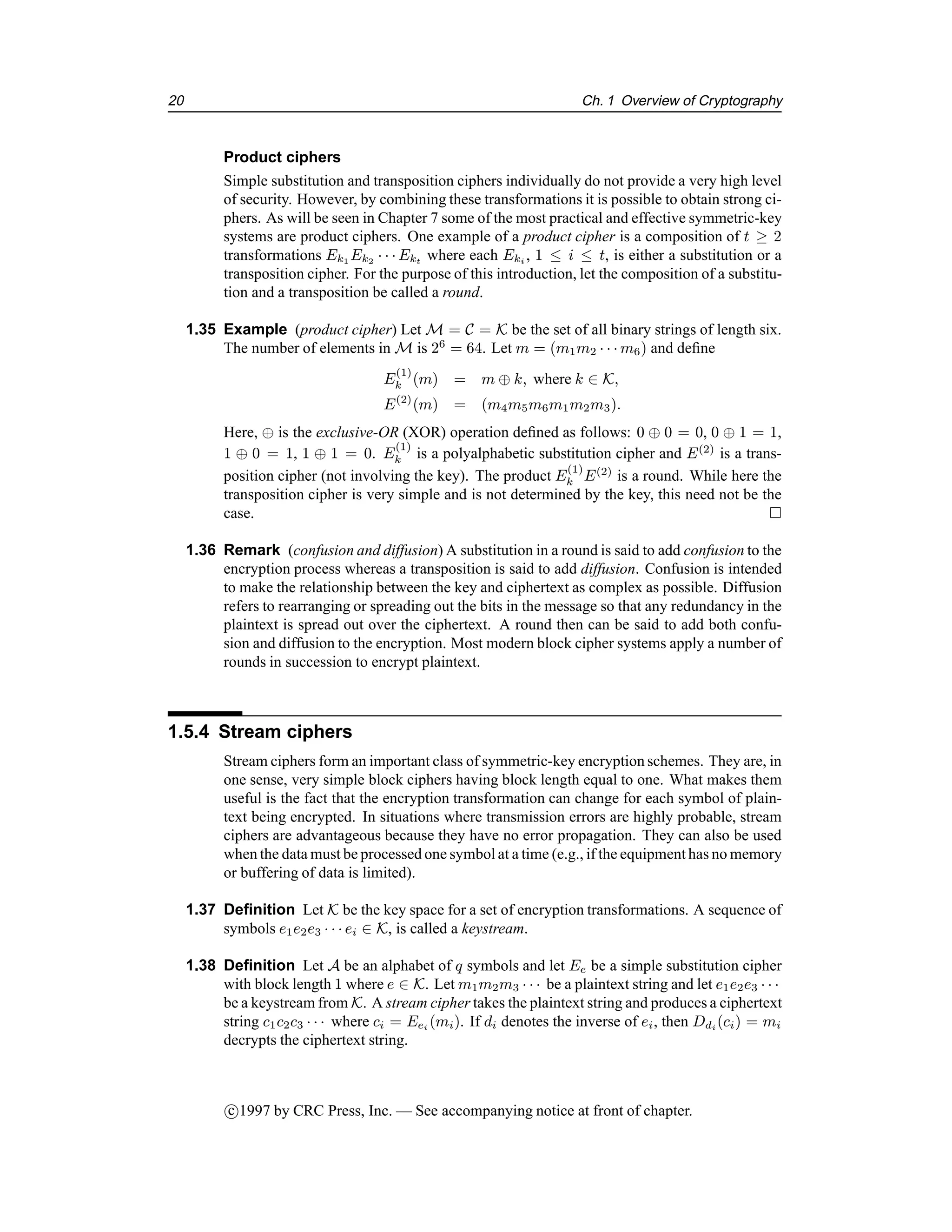
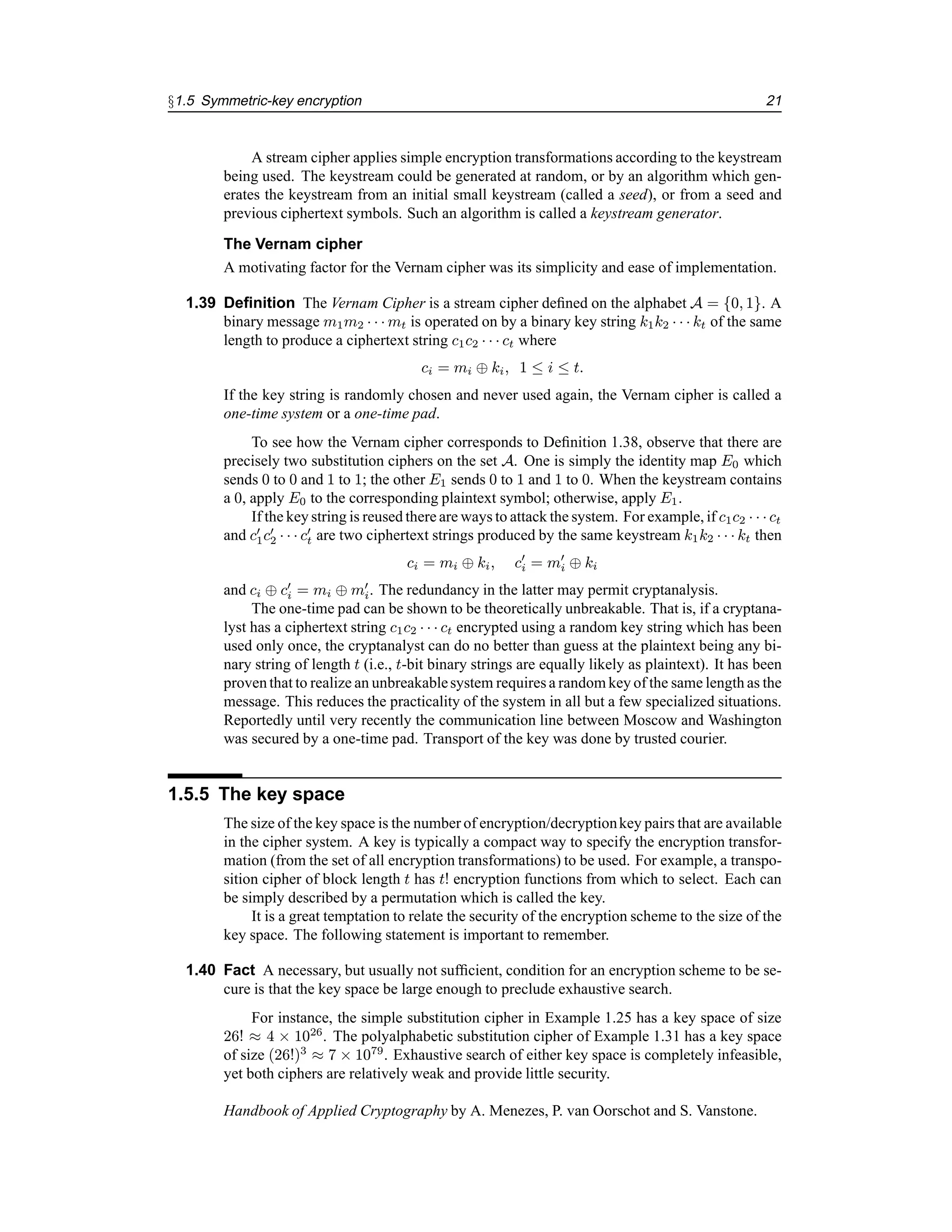
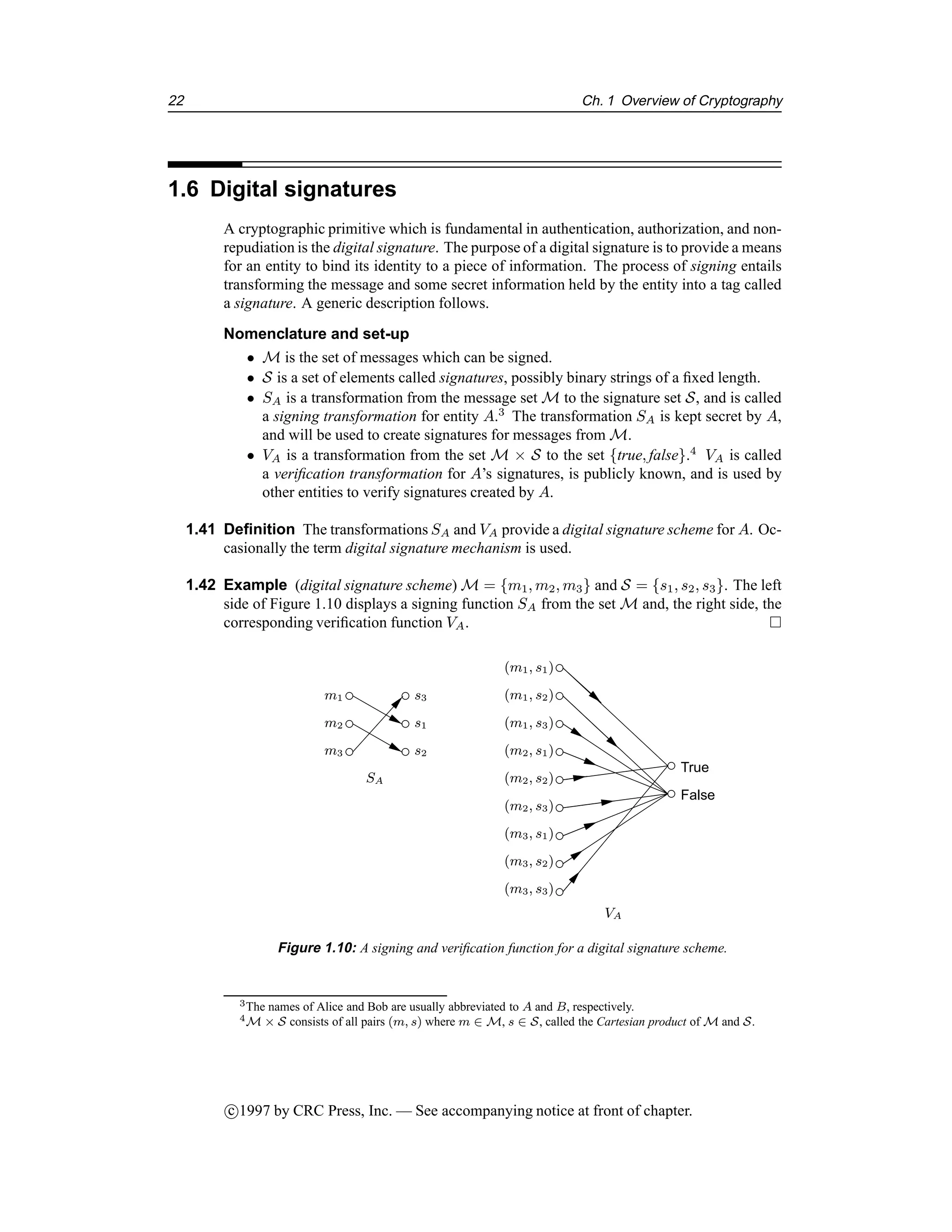

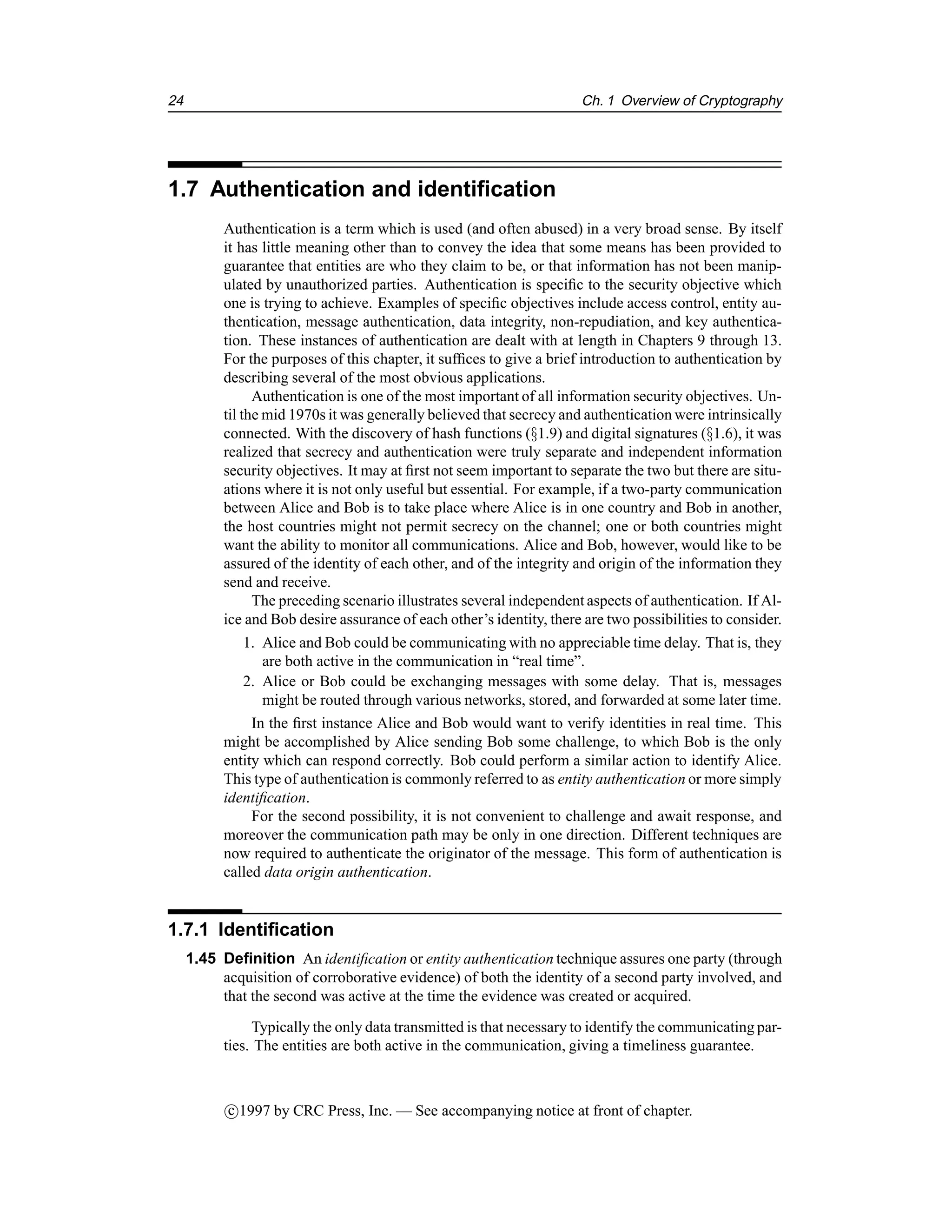
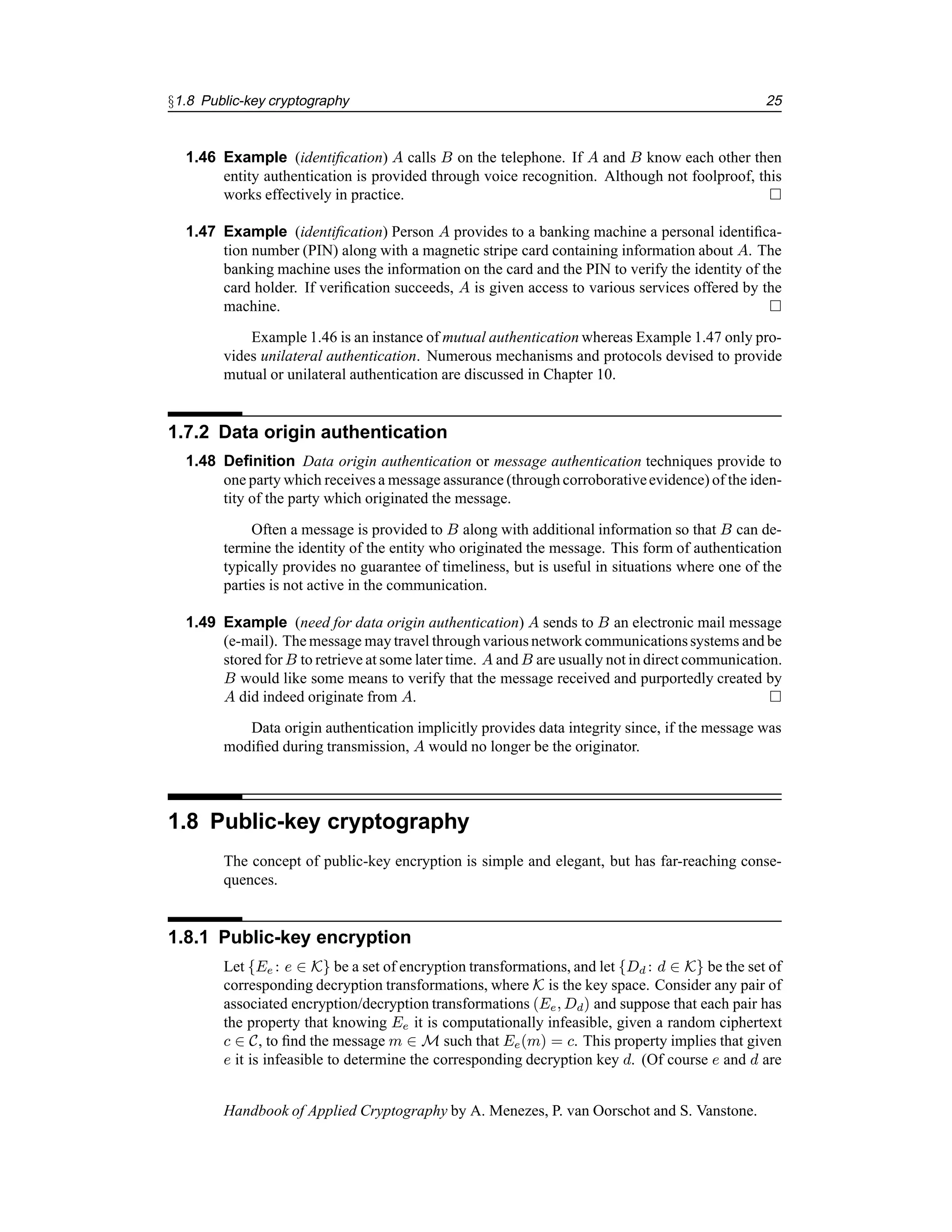
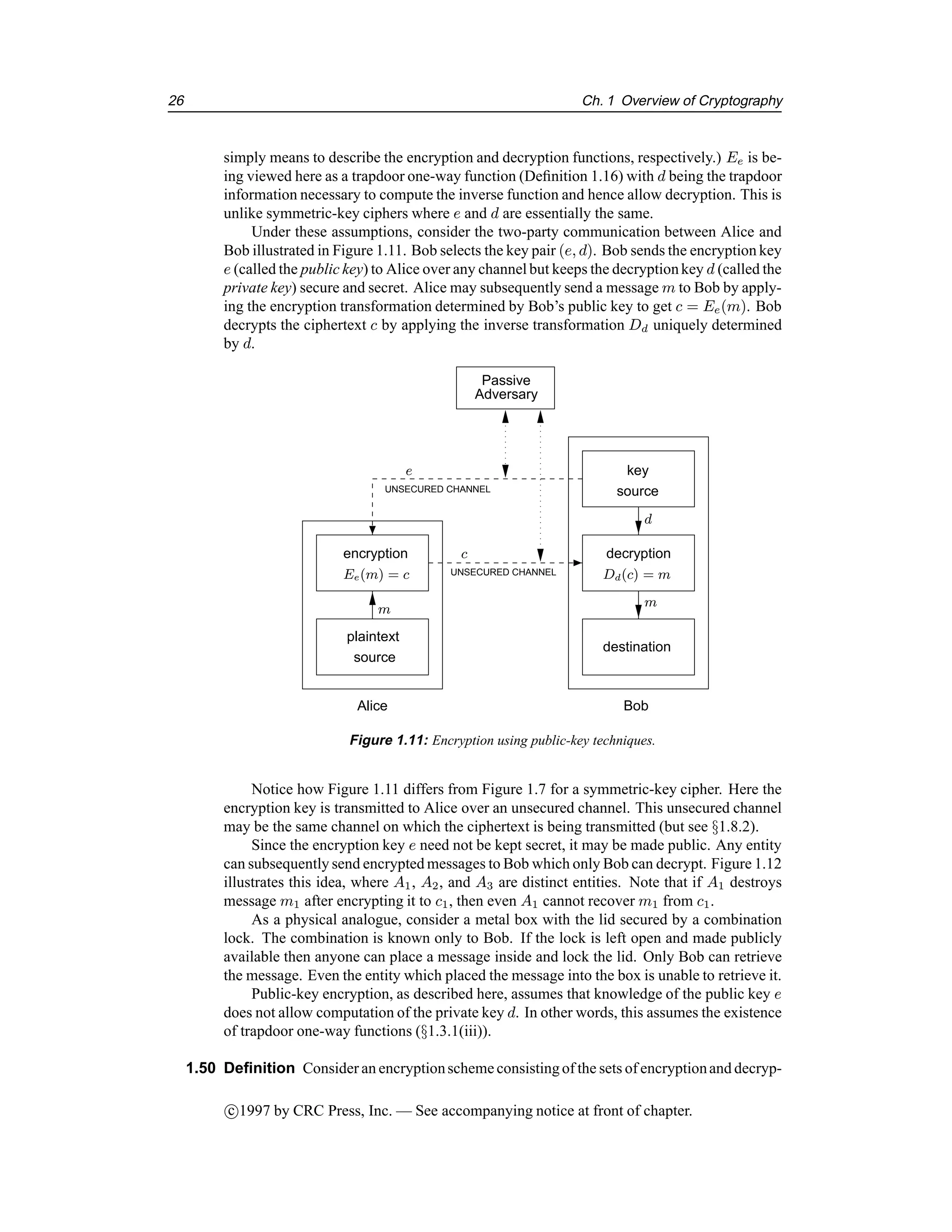
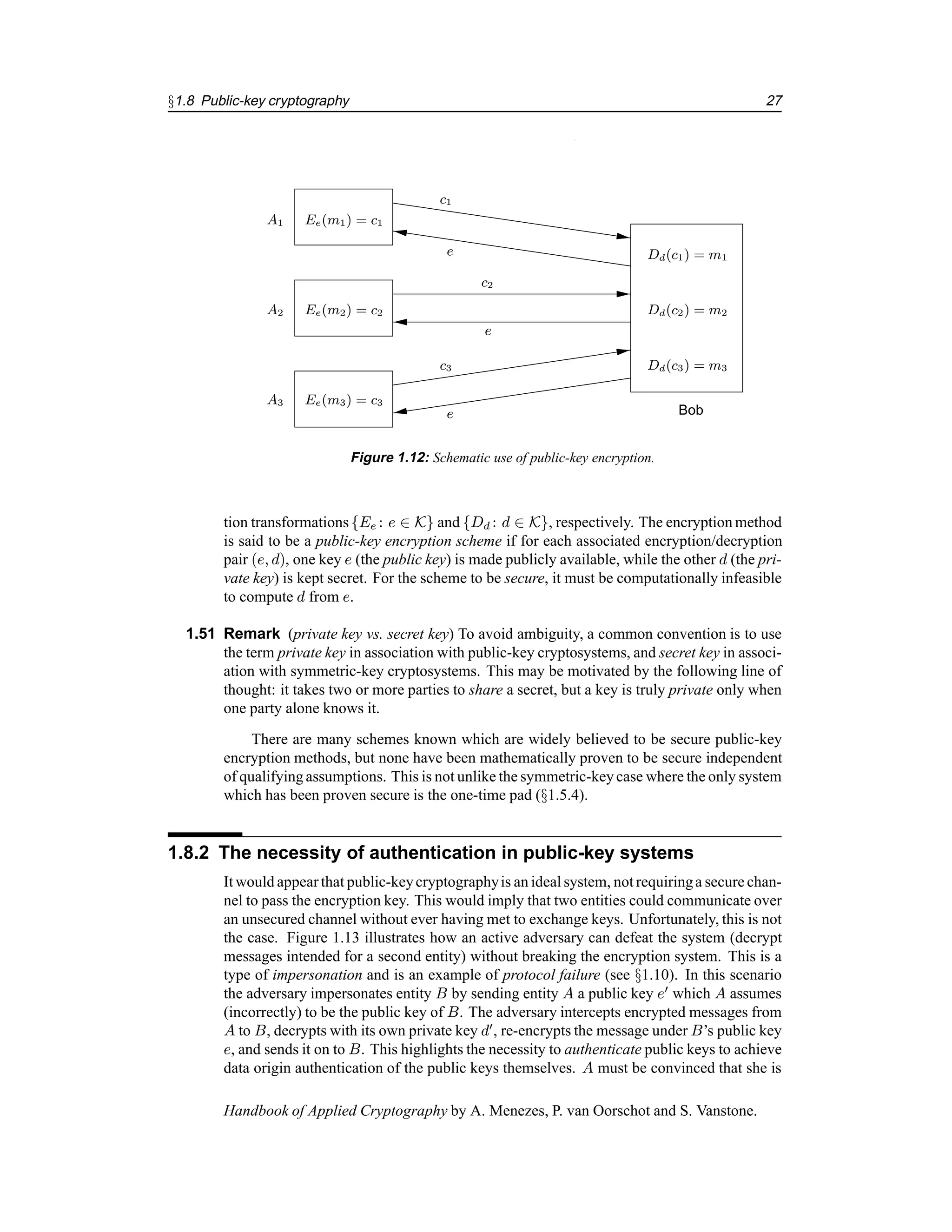


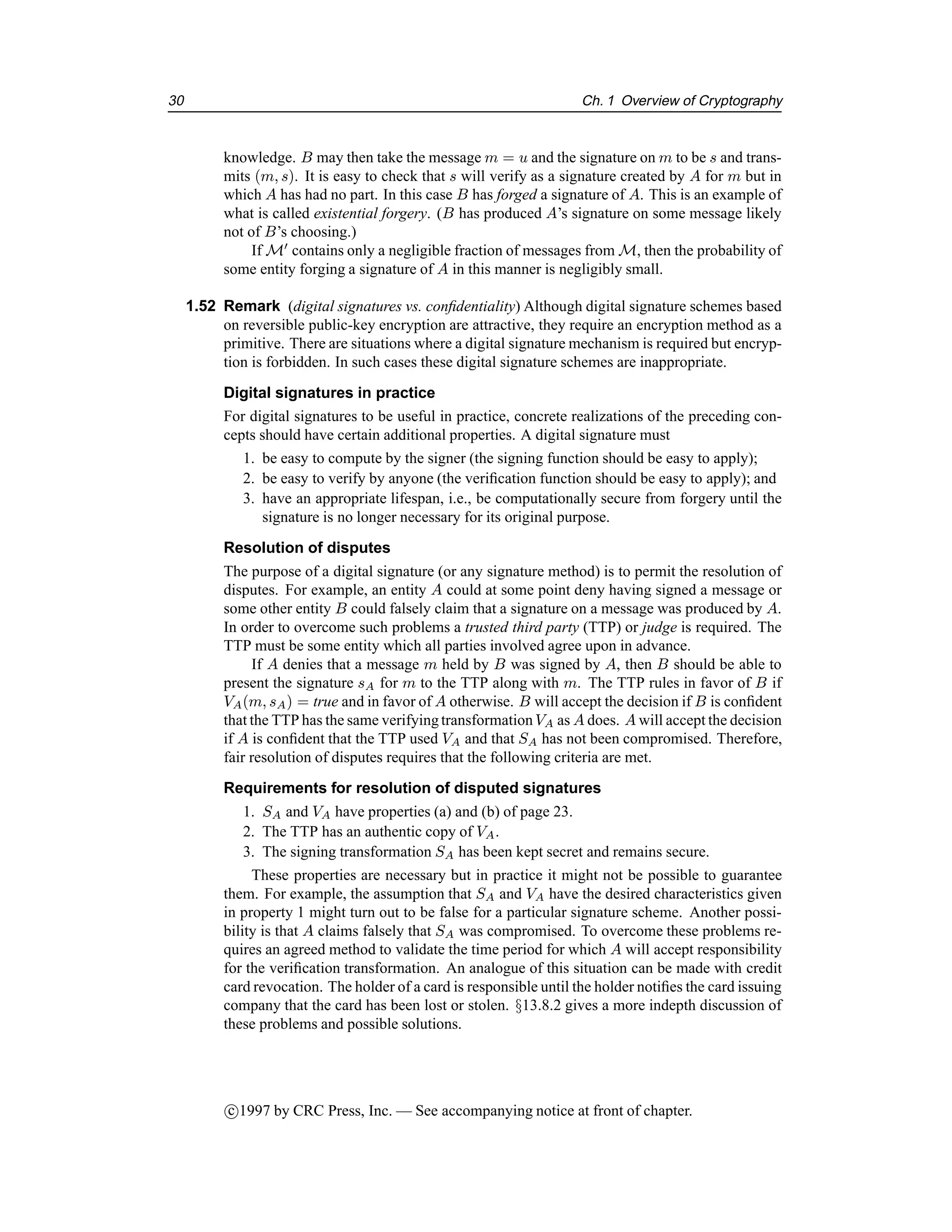



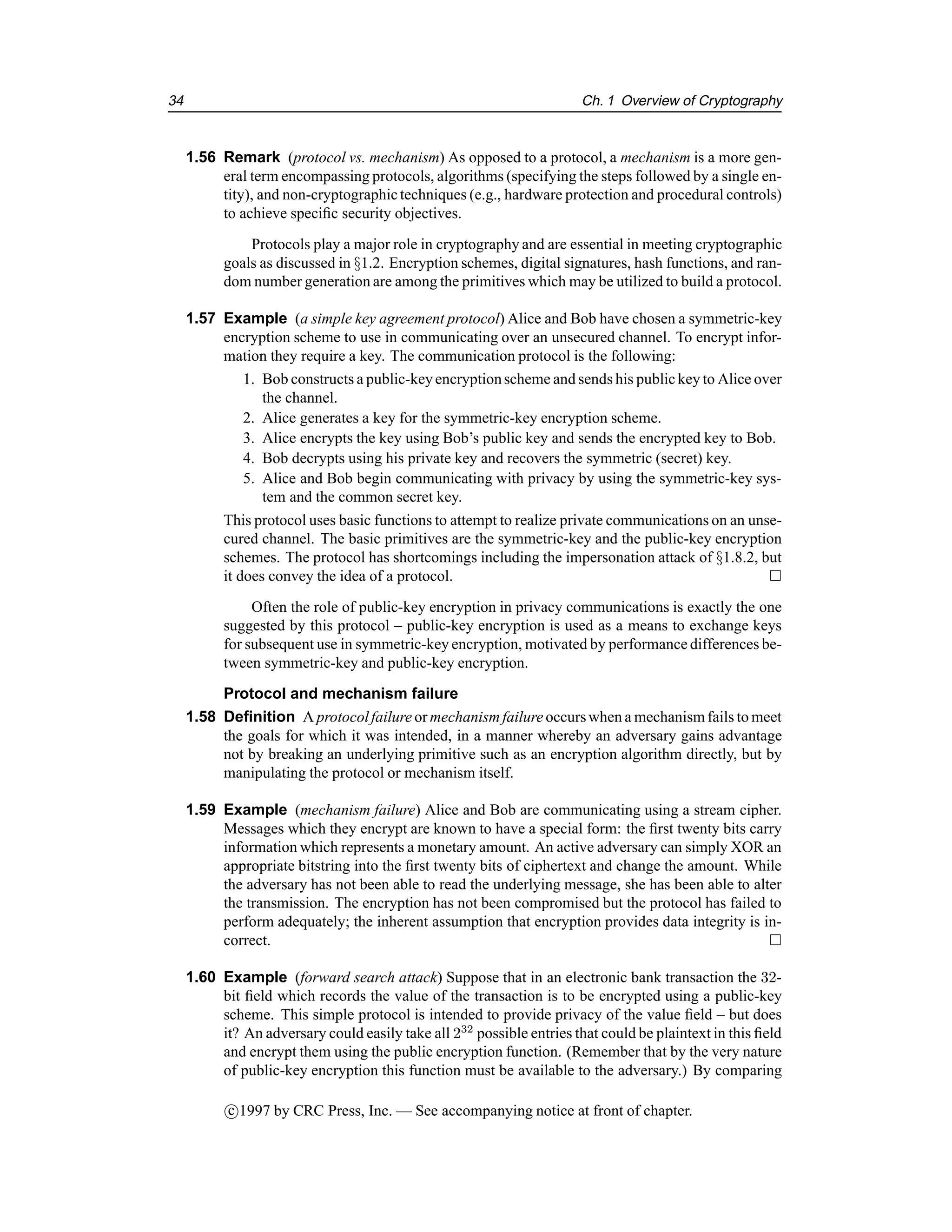
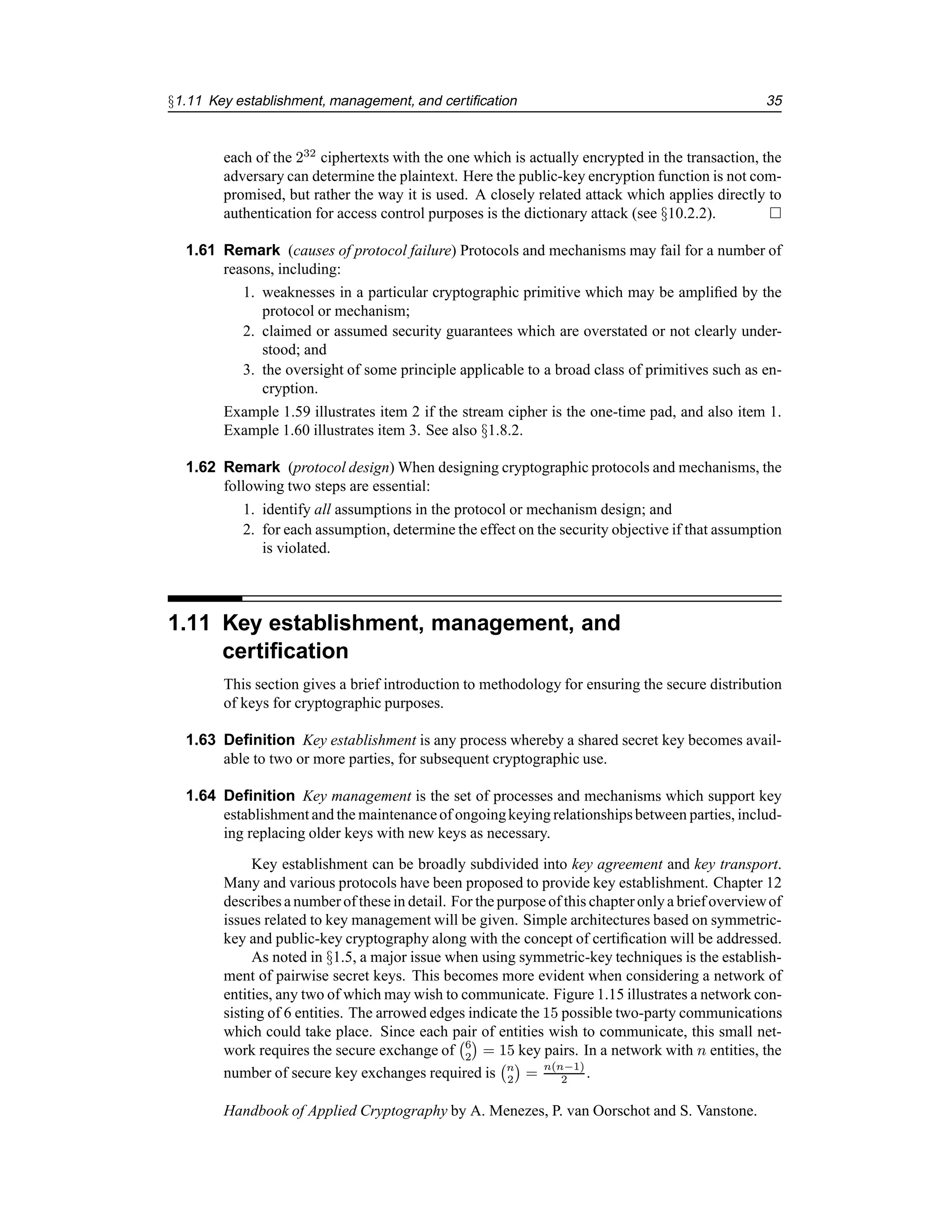
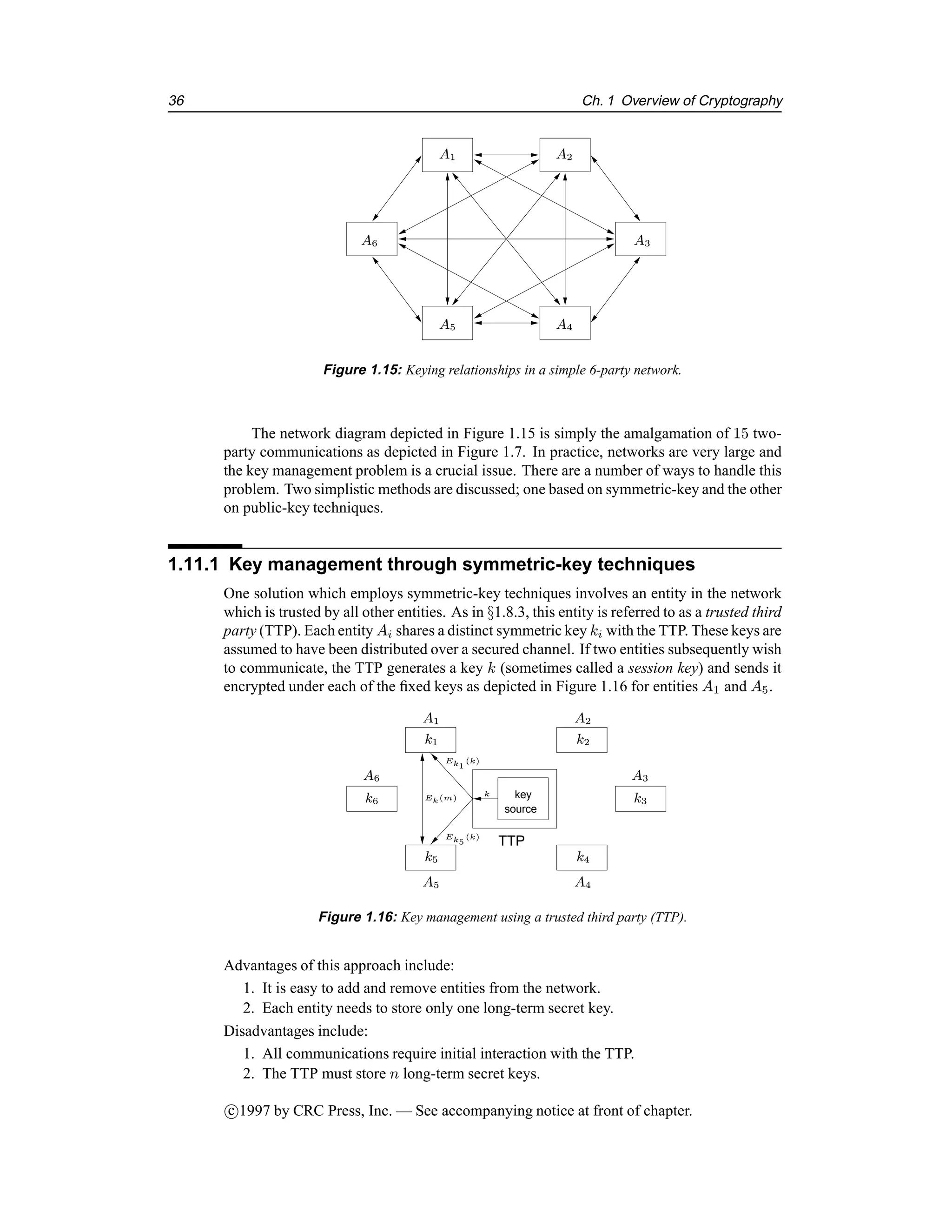
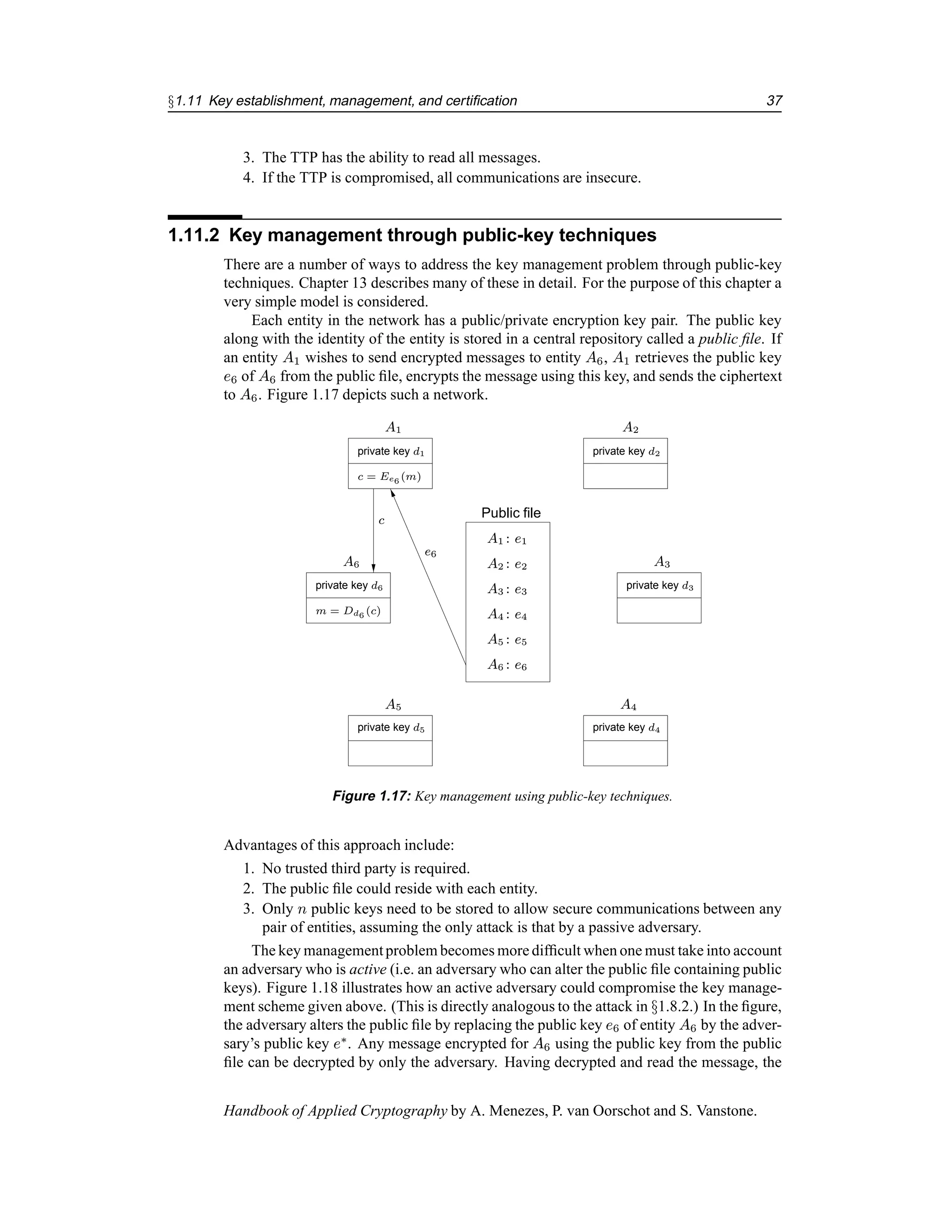
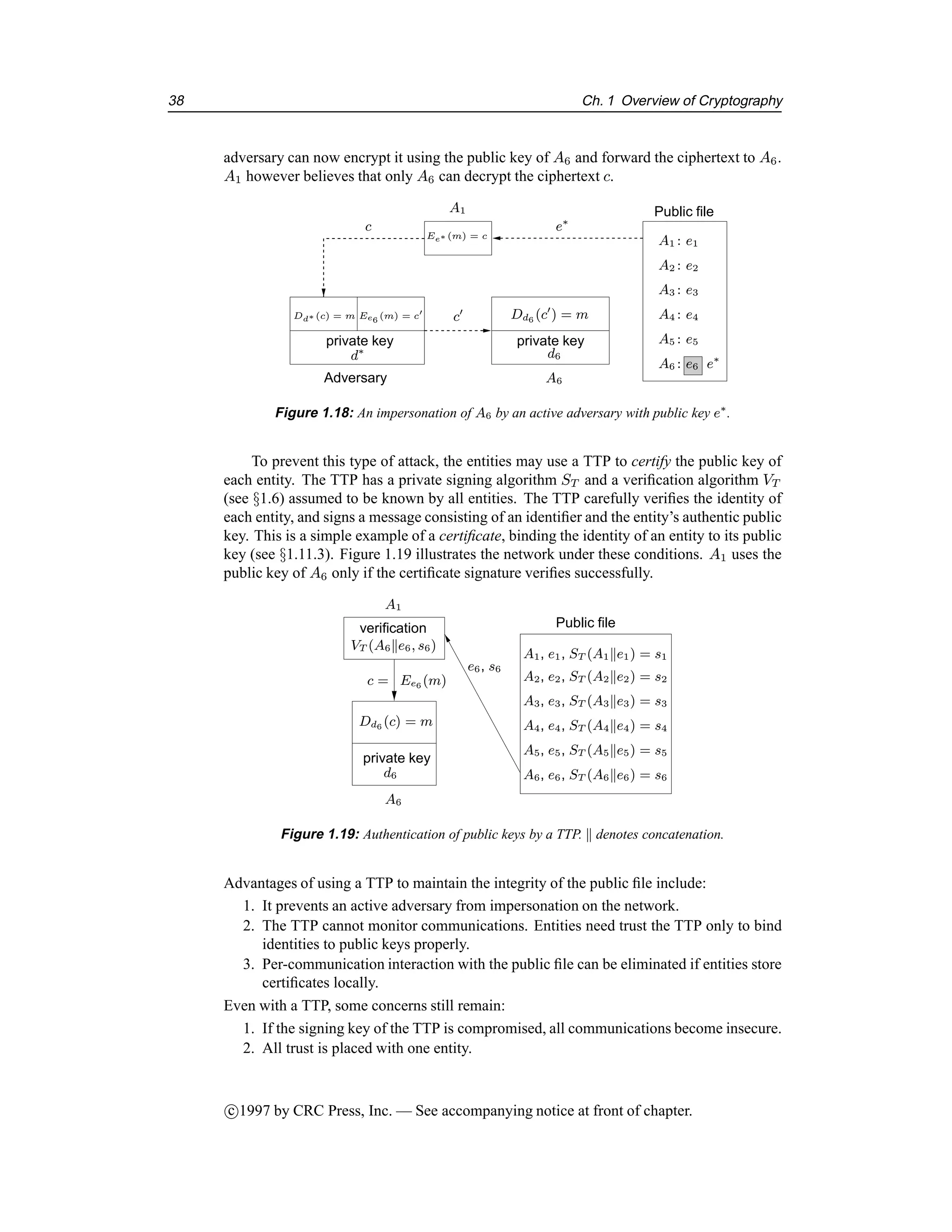
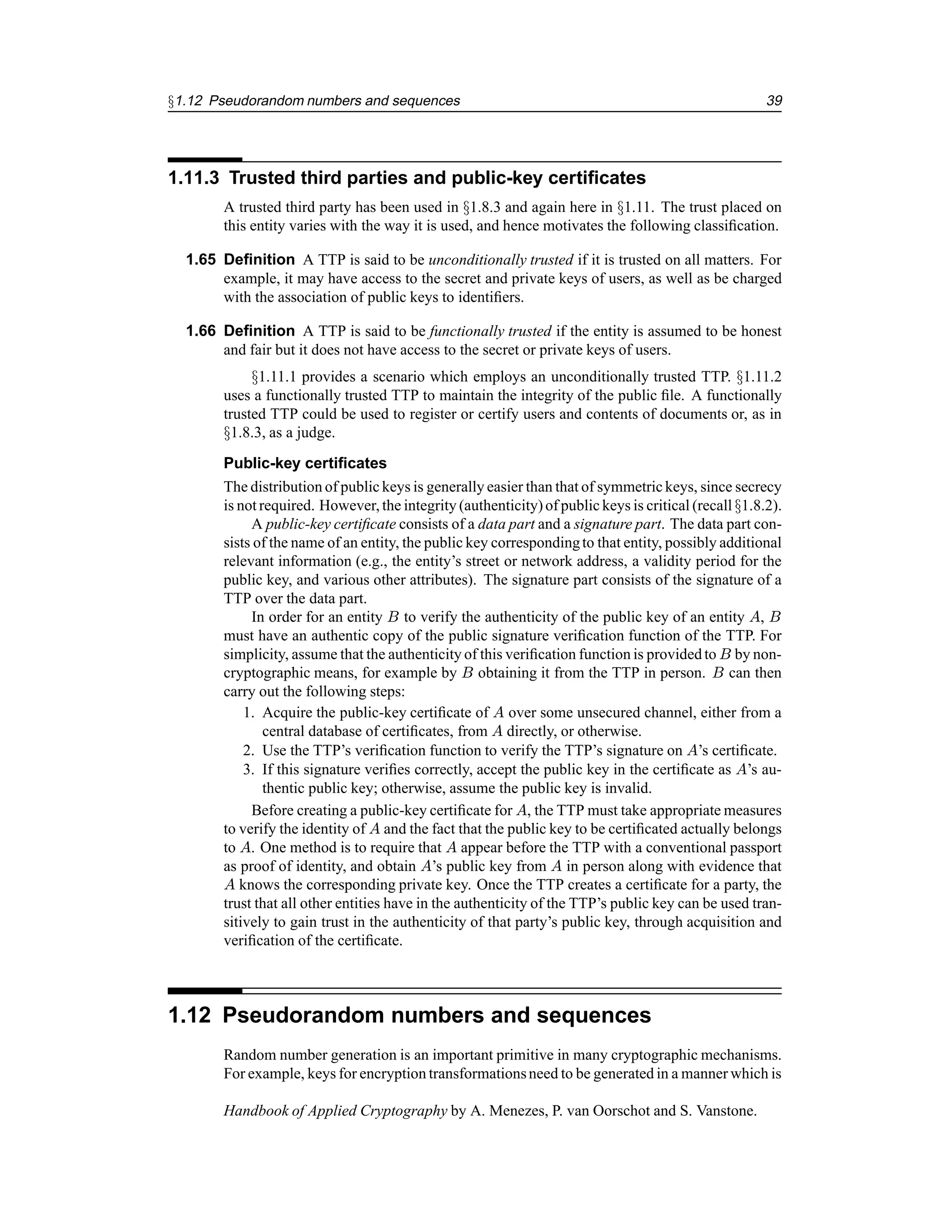
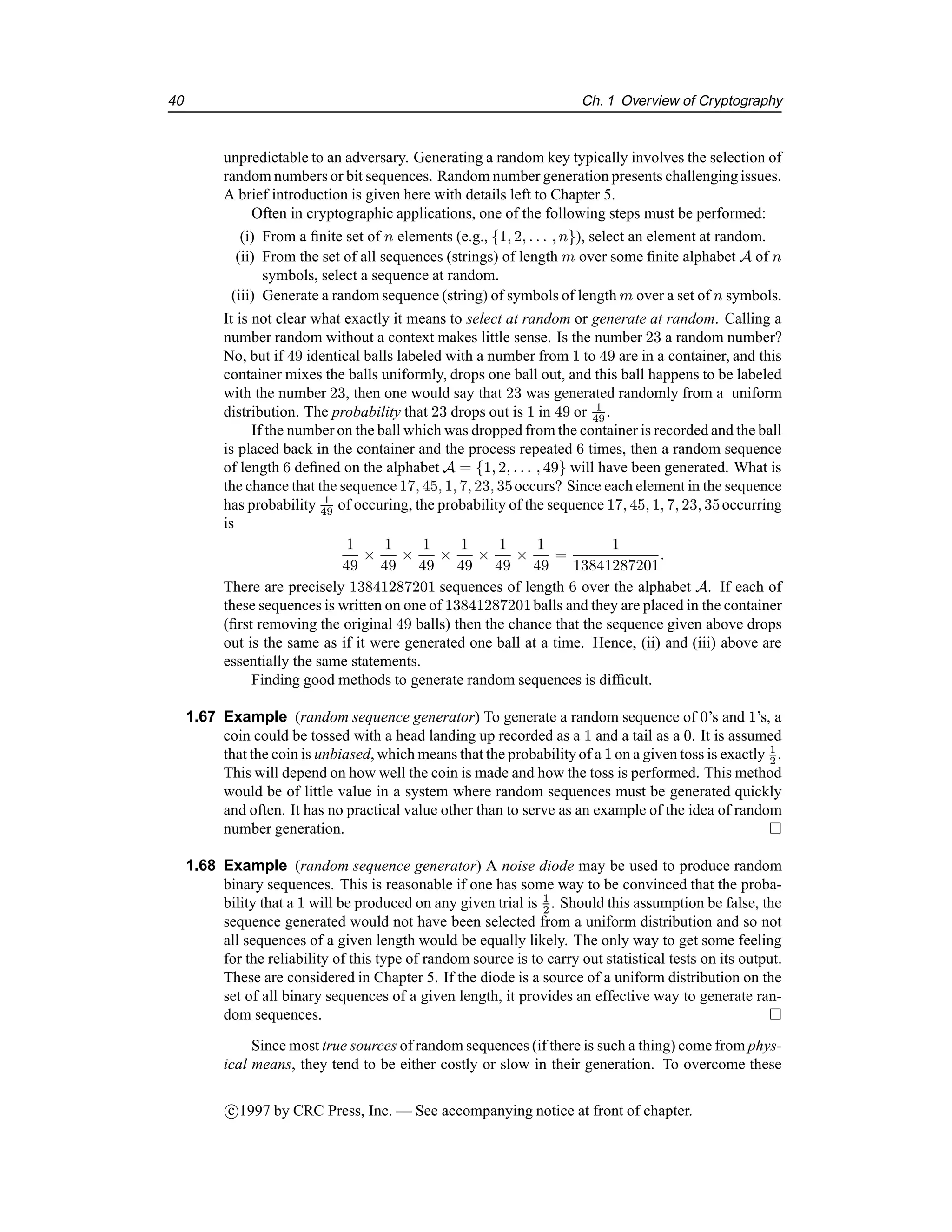
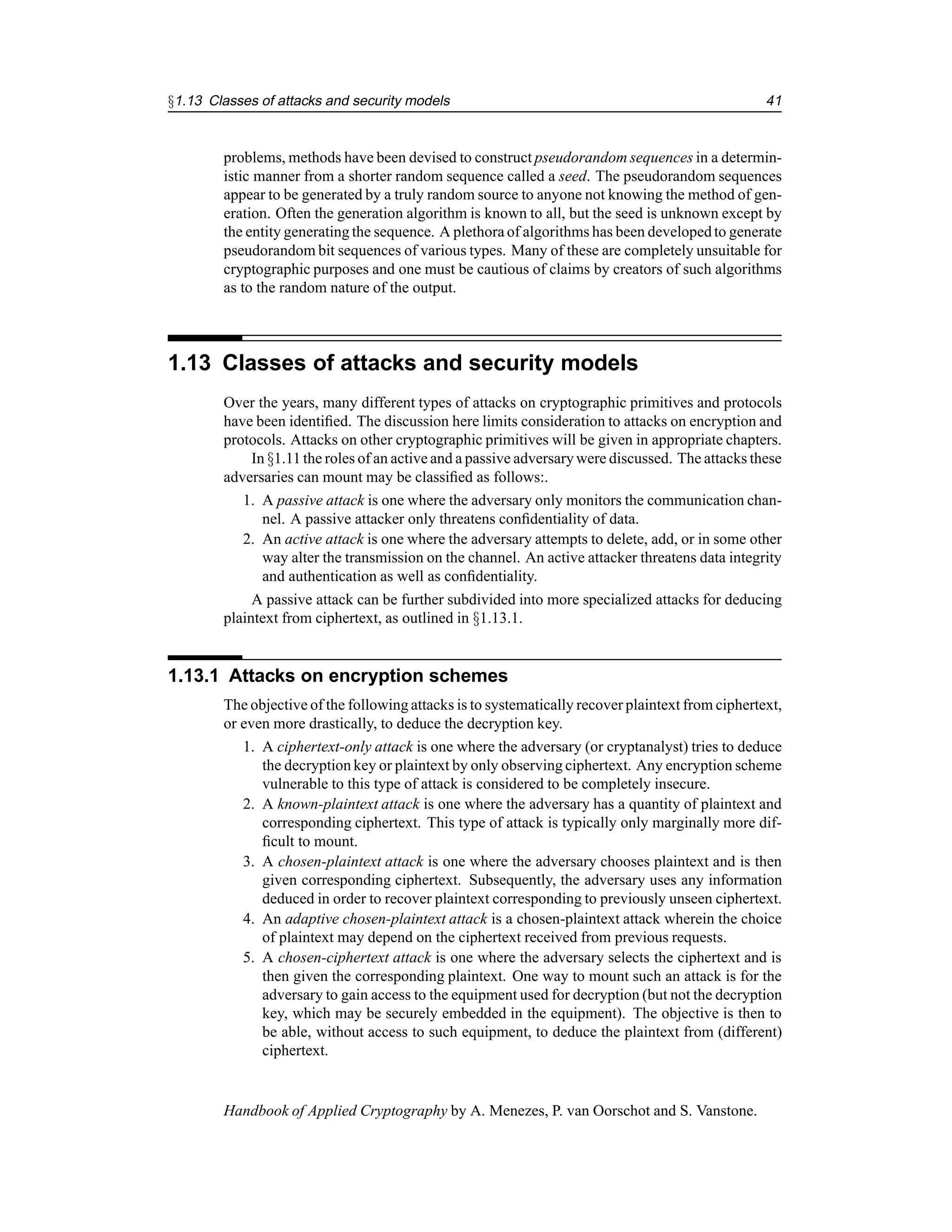
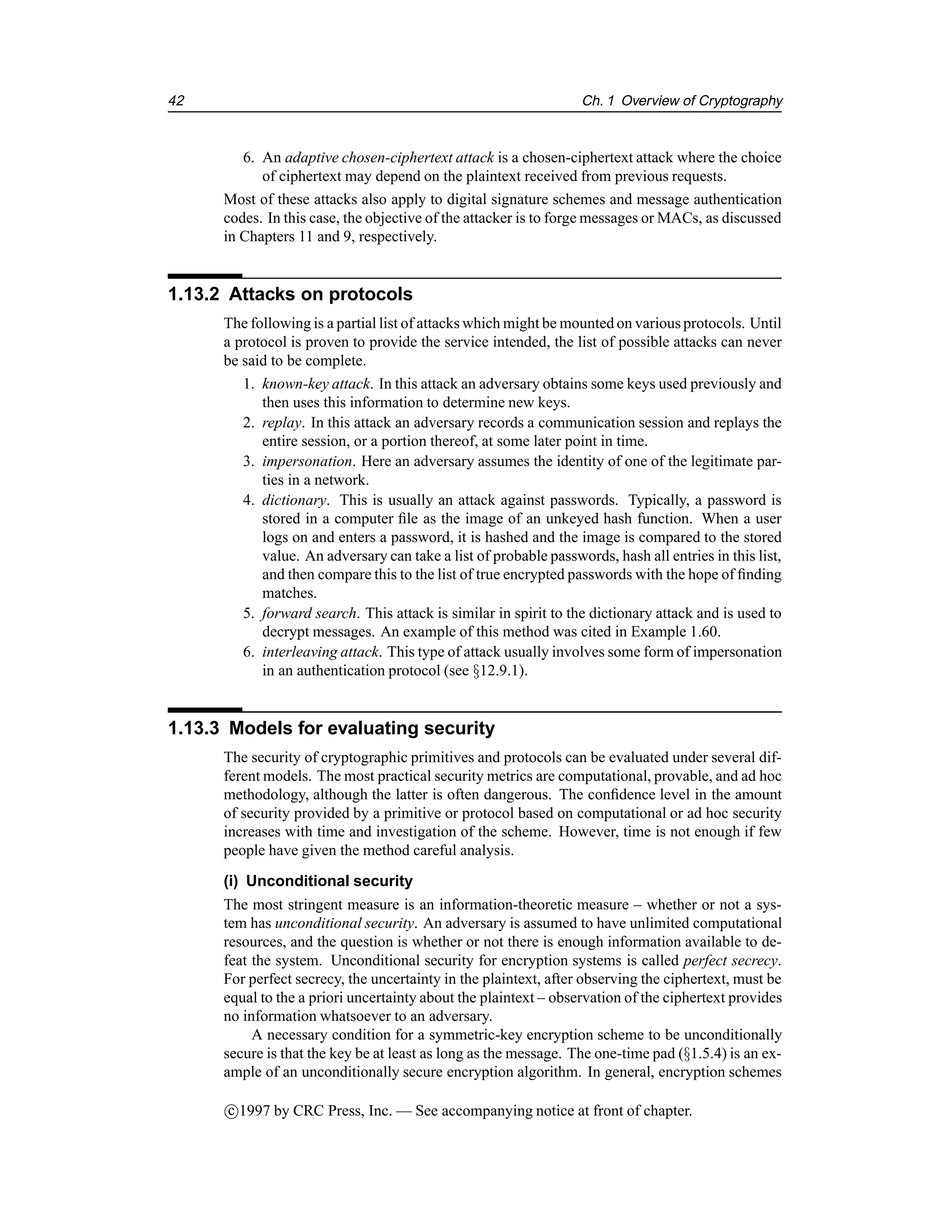
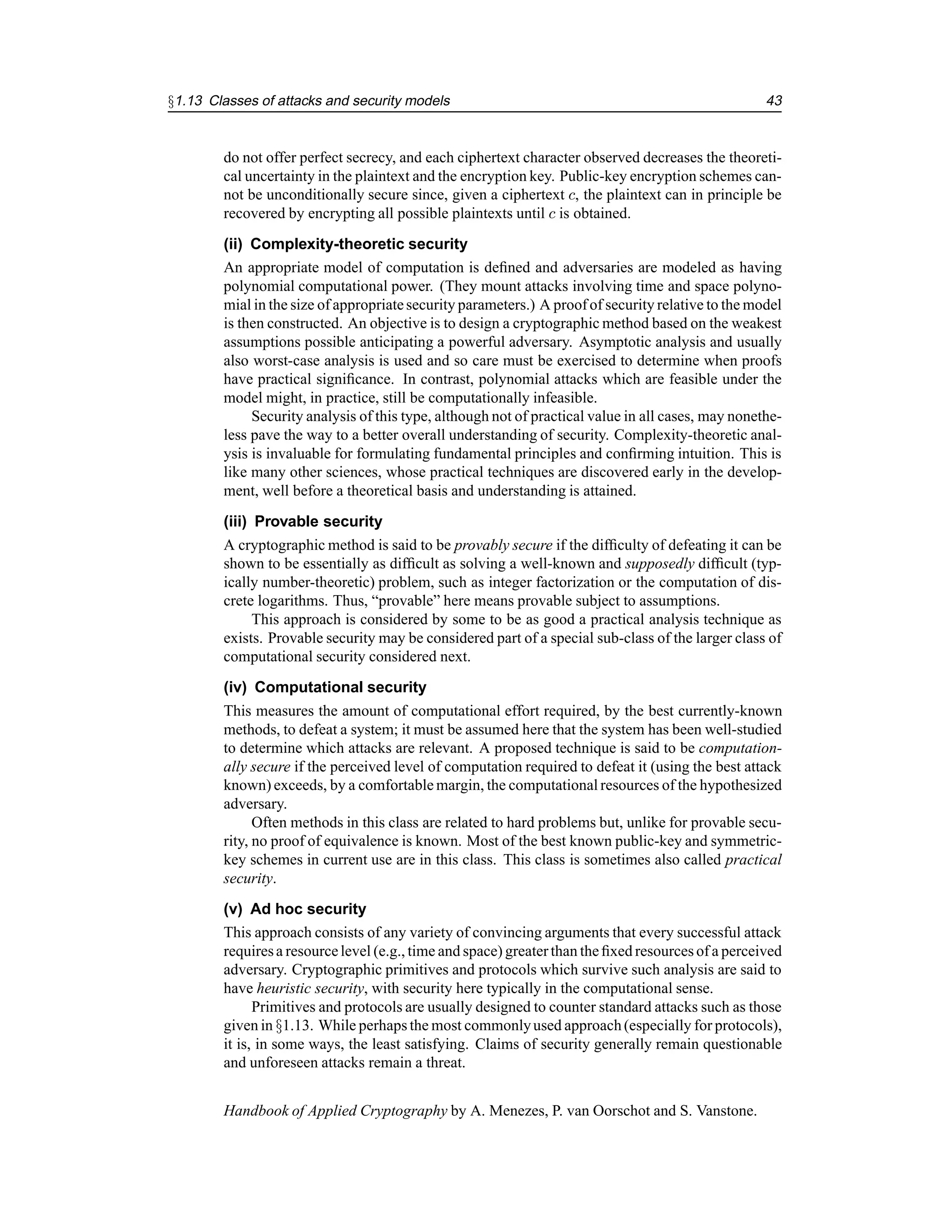

![§1.14 Notes and further references 45
Prefix Symbol Magnitude
exa E 1018
peta P 1015
tera T 1012
giga G 109
mega M 106
kilo k 103
hecto h 102
deca da 10
Prefix Symbol Magnitude
deci d 10−1
centi c 10−2
milli m 10−3
micro µ 10−6
nano n 10−9
pico p 10−12
femto f 10−15
atto a 10−18
Table 1.3: Prefixes used for various powers of 10.
1.14 Notes and further references
§1.1
Kahn [648] gives a thorough, comprehensive, and non-technical history of cryptography,
published in 1967. Feistel [387] provides an early exposition of block cipher ideas. The
original specification of DES is the 1977 U.S. Federal Information Processing Standards
Publication 46 [396]. Public-key cryptography was introduced by Diffie and Hellman
[345]. The first concrete realization of a public-key encryption scheme was the knapsack
scheme by Merkle and Hellman [857]. The RSA public-key encryption and signature sch-
eme is due to Rivest, Shamir, and Adleman [1060], while the ElGamal public-key encryp-
tion and signature schemes are due to ElGamal [368]. The two digital signature standards,
ISO/IEC 9796 [596] and the Digital Signature Standard [406], are discussed extensively in
Chapter 11.
Cryptography has used specialized areas of mathematics such as number theory to realize
very practical mechanisms such as public-keyencryptionand digital signatures. Such usage
was not conceived as possible a mere twenty years ago. The famous mathematician, Hardy
[539], went as far as to boast about its lack of utility:
“ . . . both Gauss and lesser mathematicians may be justified in rejoicing that
there is one science at any rate, and that their own, whose very remoteness from
ordinary human activities should keep it gentle and clean.”
§1.2
This section was inspired by the foreword to the book Contemporary Cryptology, The Sci-
ence of Information Integrity, edited by Simmons [1143]. The handwritten signature came
into the British legal system in the seventeenth century as a means to provide various func-
tions associated with information security. See Chapter 9 of Meyer and Matyas [859] for
details.
This book only considers cryptography as it applies to information in digital form. Chapter
9 of Beker and Piper [84] provides an introduction to the encryption of analogue signals,
in particular, speech. Although in many cases physical means are employed to facilitate
privacy, cryptography plays the major role. Physical means of providing privacy include
fiber optic communication links, spread spectrum technology, TEMPEST techniques, and
Handbook of Applied Cryptography by A. Menezes, P. van Oorschot and S. Vanstone.](https://image.slidesharecdn.com/chap1-220609100137-8616c1c4/75/chap1-crypto-pdf-46-2048.jpg)
![46 Ch. 1 Overview of Cryptography
tamper-resistant hardware. Steganography is that branch of information privacy which at-
tempts to obscure the existence of data through such devices as invisible inks, secret com-
partments, the use of subliminal channels, and the like. Kahn [648] provides an historical
account of various steganographic techniques.
Excellent introductions to cryptography can be found in the articles by Diffie and Hellman
[347], Massey [786], and Rivest [1054]. A concise and elegant way to describe cryptogra-
phy was given by Rivest [1054]: Cryptography is about communication in the presence of
adversaries. The taxonomy of cryptographic primitives (Figure 1.1) was derived from the
classification given by Bosselaers, Govaerts, and Vandewalle [175].
§1.3
The theory of functions is fundamental in modern mathematics. The term range is often
used in place of image of a function. The latter, being more descriptive, is preferred. An
alternate term for one-to-one is injective; an alternate term for onto is surjective.
One-way functions were introduced by Diffie and Hellman [345]. A more extensive history
is given on page 377. Trapdoor one-way functions were first postulated by Diffie and Hell-
man [345] and independently by Merkle [850] as a means to obtain public-key encryption
schemes; several candidates are given in Chapter 8.
§1.4
The basic concepts of cryptography are treated quite differently by various authors, some
being more technical than others. Brassard [192] provides a concise, lucid, and technically
accurate account. Schneier [1094] gives a less technical but very accessible introduction.
Salomaa [1089], Stinson [1178], and Rivest [1054] present more mathematical approaches.
Davies and Price [308] provide a very readable presentation suitable for the practitioner.
The comparison of an encryption scheme to a resettable combination lock is from Diffie
and Hellman [347]. Kerckhoffs’ desiderata [668] were originally stated in French. The
translation stated here is given in Kahn [648]. Shannon [1121] also gives desiderata for
encryption schemes.
§1.5
Symmetric-key encryption has a very long history, as recorded by Kahn [648]. Most sys-
tems invented prior to the 1970s are now of historical interest only. Chapter 2 of Denning
[326] is also a good source for many of the more well known schemes such as the Caesar
cipher, Vigenère and Beaufort ciphers, rotor machines (Enigma and Hagelin), running key
ciphers, and so on; see also Davies and Price [308] and Konheim [705]. Beker and Piper
[84] give an indepth treatment, including cryptanalysis of several of the classical systems
used in World War II. Shannon’s paper [1121] is considered the seminal work on secure
communications. It is also an excellent source for descriptions of various well-known his-
torical symmetric-key ciphers.
Simple substitution and transposition ciphers are the focus of §1.5. Hill ciphers [557], a
class of substitution ciphers which substitute blocks using matrix methods, are covered in
Example 7.52. The idea of confusion and diffusion (Remark 1.36) was introduced by Shan-
non [1121].
Kahn [648] gives 1917 as the date when Vernam discovered the cipher which bears Ver-
nam’s name, however, Vernam did not publish the result until 1926 [1222]; see page 274
for further discussion. Massey [786] states that reliable sources have suggested that the
Moscow-Washington hot-line (channel for very high level communications) is no longer
secured with a one-time pad, which has been replaced by a symmetric-key cipher requiring
a much shorter key. This change would indicate that confidence and understanding in the
c
1997 by CRC Press, Inc. — See accompanying notice at front of chapter.](https://image.slidesharecdn.com/chap1-220609100137-8616c1c4/75/chap1-crypto-pdf-47-2048.jpg)
![§1.14 Notes and further references 47
ability to construct very strong symmetric-key encryption schemes exists. The one-time
pad seems to have been used extensively by Russian agents operating in foreign countries.
The highest ranking Russian agent ever captured in the United States was Rudolph Abel.
When apprehended in 1957 he had in his possession a booklet the size of a postage stamp
(17
8 × 7
8 × 7
8 inches) containing a one-time key; see Kahn [648, p.664].
§1.6
The concept of a digital signature was introduced by Diffie and Hellman [345] and indepen-
dentlyby Merkle [850]. The first practical realizationof a digital signaturescheme appeared
in the paper by Rivest, Shamir, and Adleman [1060]. Rabin [1022] (see also [1023]) also
claims to have independently discovered RSA but did not publish the result.
Most introductory sources for digital signatures stress digital signatures with message re-
covery coming from a public-key encryption system. Mitchell, Piper, and Wild [882] give
a good general treatment of the subject. Stinson [1178] provides a similar elementary but
general introduction. Chapter 11 generalizes the definition of a digital signature by allowing
randomization. The scheme described in §1.8 is referred to as deterministic. Many other
types of digital signatures with specific properties have been created, such as blind signa-
tures, undeniable signatures, and failstop signatures (see Chapter 11).
§1.7
Much effort has been devoted to developing a theory of authentication. At the forefront of
this is Simmons [1144], whose contributions are nicely summarized by Massey [786]. For
a more concrete example of the necessity for authentication without secrecy, see the article
by Simmons [1146].
§1.8
1976 marked a major turning point in the history of cryptography. In several papers that
year, Diffie and Hellman introduced the idea of public-key cryptography and gave concrete
examples of how such a scheme might be realized. The first paper on public-key cryptog-
raphy was “Multiuser cryptographic techniques” by Diffie and Hellman [344], presented
at the National Computer Conference in June of 1976. Although the authors were not sat-
isfied with the examples they cited, the concept was made clear. In their landmark paper,
Diffie and Hellman [345] provided a more comprehensive account of public-key cryptog-
raphy and described the first viable method to realize this elegant concept. Another good
source for the early history and development of the subject is Diffie [343]. Nechvatal [922]
also provides a broad survey of public-key cryptography.
Merkle [849, 850] independently discovered public-key cryptography, illustrating how this
concept could be realized by giving an elegant and ingenious example now commonly re-
ferred to as the Merkle puzzle scheme. Simmons [1144, p.412] notes the first reported ap-
plication of public-key cryptography was fielded by Sandia National Laboratories (U.S.) in
1978.
§1.9
Much of the early work on cryptographic hash functions was done by Merkle [850]. The
most comprehensive current treatment of the subject is by Preneel [1004].
§1.10
A large number of successful cryptanalytic attacks on systems claiming security are due to
protocol failure. An overview of this area is given by Moore [899], including classifications
of protocol failures and design principles.
Handbook of Applied Cryptography by A. Menezes, P. van Oorschot and S. Vanstone.](https://image.slidesharecdn.com/chap1-220609100137-8616c1c4/75/chap1-crypto-pdf-48-2048.jpg)
![48 Ch. 1 Overview of Cryptography
§1.11
One approach to distributing public-keys is the so-called Merkle channel (see Simmons
[1144, p.387]). Merkle proposed that public keys be distributed over so many independent
public channels (newspaper, radio, television, etc.) that it would be improbable for an ad-
versary to compromise all of them.
In 1979 Kohnfelder [702] suggested the idea of using public-key certificates to facilitate
the distribution of public keys over unsecured channels, such that their authenticity can be
verified. Essentially the same idea, but by on-line requests, was proposed by Needham and
Schroeder (ses Wilkes [1244]).
A provablysecure key agreementprotocol has been proposedwhose security is based on the
Heisenberg uncertainty principle of quantum physics. The security of so-called quantum
cryptography does not rely upon any complexity-theoretic assumptions. For further details
on quantum cryptography, consult Chapter 6 of Brassard [192], and Bennett, Brassard, and
Ekert [115].
§1.12
For an introductionand detailed treatment of many pseudorandomsequence generators, see
Knuth [692]. Knuth cites an example of a complex scheme to generate random numbers
which on closer analysis is shown to produce numbers which are far from random, and con-
cludes: ...random numbers should not be generated with a method chosen at random.
§1.13
The seminal work of Shannon [1121] on secure communications, published in 1949, re-
mains as one of the best introductions to both practice and theory, clearly presenting many
of the fundamentalideas includingredundancy,entropy, and unicity distance. Various mod-
els under which security may be examined are considered by Rueppel [1081], Simmons
[1144], and Preneel [1003], among others; see also Goldwasser [476].
c
1997 by CRC Press, Inc. — See accompanying notice at front of chapter.](https://image.slidesharecdn.com/chap1-220609100137-8616c1c4/75/chap1-crypto-pdf-49-2048.jpg)